






AFSCME 3299 and UPTE-CWA, representing 50,000 workers combined, strike, with multiple campus dining services closing during this time
BY KHADEEJAH KHAN campus@theaggie.org
Around 50,000 University of California workers, represented by two major unions, are set to strike on Feb. 26 to 28 across all 10 UC campuses and fve medical centers, citing unfair labor practices, interference with workers’ rights and stafng shortages.
Te workers are members of the American Federation of State, County and Municipal Employees Local 3299 (AFSCME 3299) and the University Professional and Technical Employees Local 9119 (UPTE-CWA).
AFSCME 3299, representing over 37,000 service, patient care and skilled crafts workers, is striking Feb. 26 and 27 across all 10 university campuses. At UC Davis, AFSCME 3299 workers will be striking at La Rue Road and Hutchinson Drive, as well as the UC Davis Medical Center in Sacramento.
In the AFSCME 3299 press release announcing the strike, the union alleged that the UC had negotiated in bad faith, failed to provide wages that meet the cost of living and limited workers’ rights to speech, protest and assembly under threat of discipline or arrest. Previous contracts with the UC expired in July and October 2024, and bargaining began again in
History

January 2024. Te two parties have yet to come to an agreement.
“By refusing to bargain in good faith, the University has made it clear that it does not value the frontline workers who clean its facilities, serve food and treat patients,” AFSCME Local 3299 President Michael Avant said in a statement. “UC’s eforts to illegally silence dissent from workers who are struggling the most is suggestive of an efort to concentrate even more power and wealth for its ivory tower elites. Tis is not a solution to the workforce supply and affordability problems facing this institution, but a glaring symptom of the problem that is driving workers onto picket lines.”
UPTE-CWA, representing over 19,000 health care, research and technical employees, is striking Feb. 26 through Feb. 28. Te union will be striking outside of the UC Davis Veterinary Hospital and in front of UC Davis Medical Center in Sacramento.
In their announcement in the Los Angeles Times, the union alleged staf shortages that harm patient care and research operations, bad faith negotiations and raised healthcare costs. Tey believe the UC implemented “draconian” restrictions on workers who striked for two days at UC San Francisco.
“We’re hoping this will send a
Davis
Adam Zientek’s lecture on how fascism was allowed to flourish in a democratic
The lecture defined fascism in a way that echoes present-day American politics while warning the consequences of inaction
BY JULIE HUANG arts@theaggie.org
On Feb. 18, the UC Davis Department of History held a lecture given by Professor Adam Zientek on the “Machtergreifung,” referring to Adolf Hitler’s rise to power in 1930s Germany.
Over the course of an hour and 20 minutes, Zientek sought to detail the process by which Hitler established a fascist dictatorship within a highly literate and cultured republic, revealing how quickly fascism takes root even in societies that are committed to democracy.
“I’ll give the moral of the story away at the beginning,” Zientek said. “Hitler only came to power because he had lost.” After Germany’s tremendous losses in World War I, many Germans turned to the “stab-in-the-back” myth as a soothing explanation for their defeat. Many small, right-wing political parties, known as “patriot parties,” promoted the idea that Germany’s loss was caused by traitorous internal enemies, which included socialists, communists and Jewish people, who had betrayed the invincible German army when they sued for peace in
1918. Tis narrative, although not grounded in reality, resonated strongly with middle-class German veterans, one of whom was Hitler. Only after Germany’s defeat in World War I did Hitler resolve to become a politician, becoming drawn to the German Workers’ Party, a small, far-right party that subscribed to the stab-in-the-back myth. Tey shared a group identity as honorable and brave patriots who had their glory taken from them by the left, the French and the Jews, stewing in resentment and shame,” Zientek said. “Tey were exactly Hitler’s kind of people.”
Following his entry into the German Workers’ Party, Hitler spent years honing his oratorical skills in the beer hall where the group met.
“Up to 6,000 people a night would sit transfxed and listen to him as he raved that only he could protect Germany from Jews and save Germany from international bankers,” Zientek said. “Hitler’s language in these speeches was ugly, brutal, coarse and omitting facts — a program that you’d think would be unpopular, but you’d be wrong.” In 1923, Hitler attempted a coup d’etat and was convicted of treason. Yet being prosecuted made him more
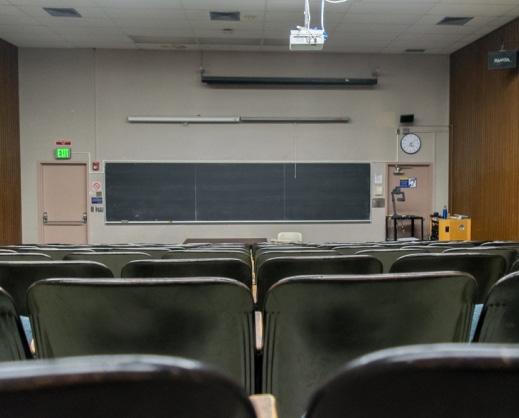
popular than ever, and attempts to hold him accountable only increased his infuence and his belief that he was the victim of political persecution.
“Hitler’s coup taught him the lesson that overthrowing a democratic state was not done through violence,” Zientek said. “Trough legal means, he could pervert and then take over the parliamentary institutions of government to establish a one-party state.”
Millions of Germans who had never heard of him read about his trial in the newspaper, giving him a platform to promote his ideas.
“Nazism became about winning hearts and minds, blackening the former and emptying the latter,” Zientek said. “Hitler’s goal was to win enough votes to destroy the opposition once and for all.”
Yet Hitler’s brand of far-right extremism was unpopular in 1920s Germany due to growing economic prosperity and cultural optimism. Germany experienced a series of diplomatic victories in the 1920s, was welcomed back into the League of Nations and largely reintegrated into the European economy by 1929.
Only after the economic crash of 1929 did interest in the Nazis’ radical solutions begin to grow.
Tis was devastating for the living standards of ordinary Germans, and it seemed to prove that democracy, liberalism and capitalism had failed catastrophically,” Zientek said. “Tese things that had promised prosperity and peace produced a world in shambles. Te German people looked for alternatives, and the Nazis had them.”

message to UC about our members being fed up with these unfair labor practices,” UPTE President Dan Russell said in the statement. “We hope this will produce a change in UC’s behavior.”
During the strike, Latitude Restaurant and Market, Scrubs, Te Gunrock, Spokes and the meal card ofce will be temporarily closed from Feb. 26 to Feb. 27, according to Student Housing and Dining Services. Segundo, Tercero and Cuarto Dining Commons and their markets will remain open. Additionally, all Peet’s Cofee locations (with the exception of the Scrubs location), Silo Market, Sage Street Market and the food trucks outside of the silo will remain open with regular
hours during the strike.
A UC spokesperson has denied a stafng shortage or claims of silencing unions and claimed the UC has “continuously reached out to the unions in an attempt to settle these contracts.”
“While both AFSCME and UPTE may say they want UC to return to the table, the successful resolution of these contracts depends on their willingness to engage in productive bargaining,” UC said in a statement. “Te University will do everything possible to ensure strike impacts on patients, students, faculty and staf are mitigated.”
Students should not expect signifcant changes in campus operations during the strike, according to a UC Davis spokesperson.
“We expect instruction, research and other campus operations to proceed without significant disruption,” the UC Davis spokesperson said. “Service levels in our dining halls and some other food outlets will be adjusted for the duration of the strike.”
Editor’s note: Follow along with The California Aggie’s website for more information as the strike progresses daily and for any information about potential resolutions between the university and the unions.
Various students and campus leaders reflect on the Principles of Community’s role on campus
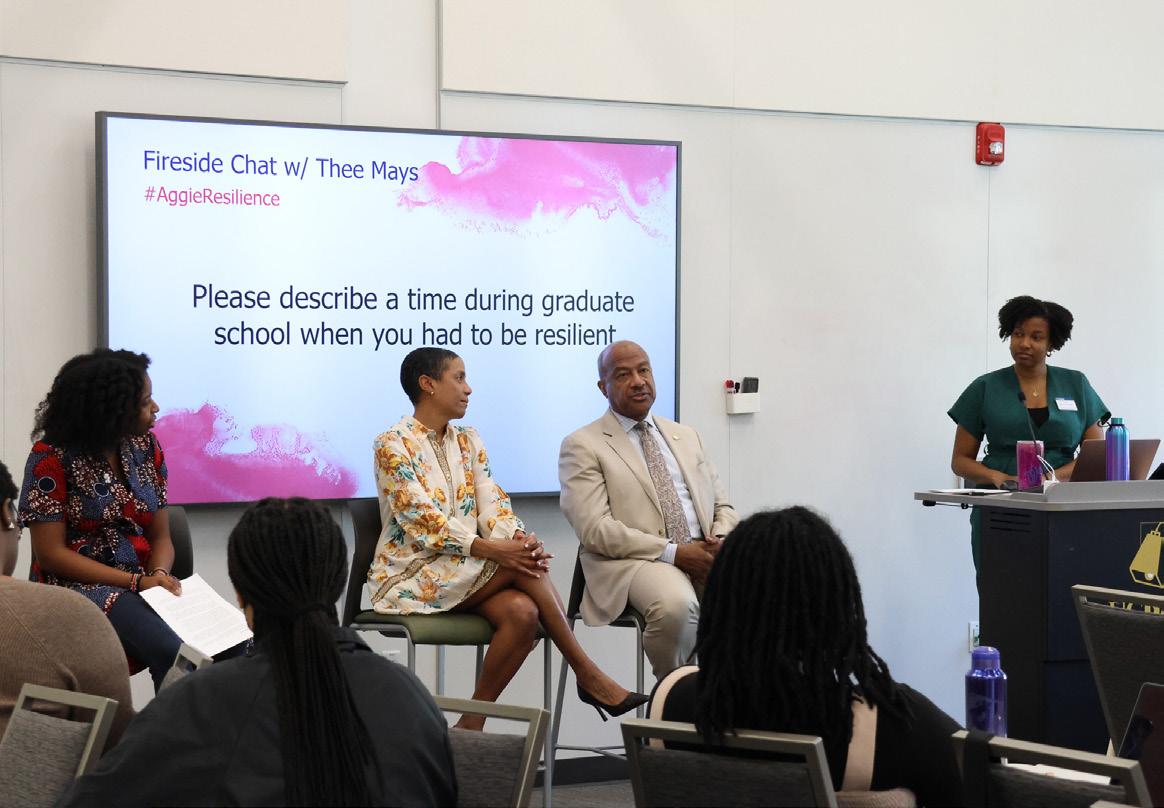
BY JESSICA YUNG campus@theaggie.org
During the month of February, UC Davis celebrated the 35-year anniversary of the Principles of Community. Diferent campus units hosted various events pertaining to the values that the mantra promotes. The Principles of Community are statements about the importance of community itself, the multiplicity of identities found at UC Davis and having a sense of belonging on campus, according to the UC Davis Diversity, Equity and Inclusion (DEI) website. Te website states the Principles of Community in full, describing a commitment to respect and the importance of being open-minded and accepting.
“We afrm the dignity inherent in all of us and we strive to maintain a climate of equity and justice demonstrated by respect for one another,” the website reads. “We acknowledge that our society carries within it historical and deep-rooted injustices and biases. Terefore, we endeavor to foster mutual understanding and respect among the many parts of our whole.”
Te Principles of Community were created by a group of student activists within Student Housing in the late 1980s, according to the DEI website. Te student activists desired and created
a statement of values to ensure respect among diverse groups of community members.
In 1990, the student leaders created the Principles of Community, which the DEI website describes as one of the frst statements to be adopted by a university.
“Their work culminated in the adoption of the Principles of Community in 1990, making UC Davis one of the frst universities in the country to establish a campus wide statement of values addressing equity, access, diversity and mutual respect,” the website reads. “Tis initiative refected the university’s longstanding belief that supporting diversity and inclusion is integral to academic excellence and community building.”
Mikael Villalobos, Ed.D, an alumnus that was involved with the creation of the Principles of Community and the associate vice chancellor for the Ofce of Campus and Community Relations in the Office for DEI, discussed the goal of the mantra.
Te Principles of Community are a call to let students know that they belong to the university,” Villalobos said. “It’s a core component of who we are as a university, and for many students, the pressures of fnding their community can be immense, because [...] a support system at the university setting is so important [and] very crucial in student success.”
NorCal’s finest felines are put to the test in The Cat Fanciers’ Association’s various competitions
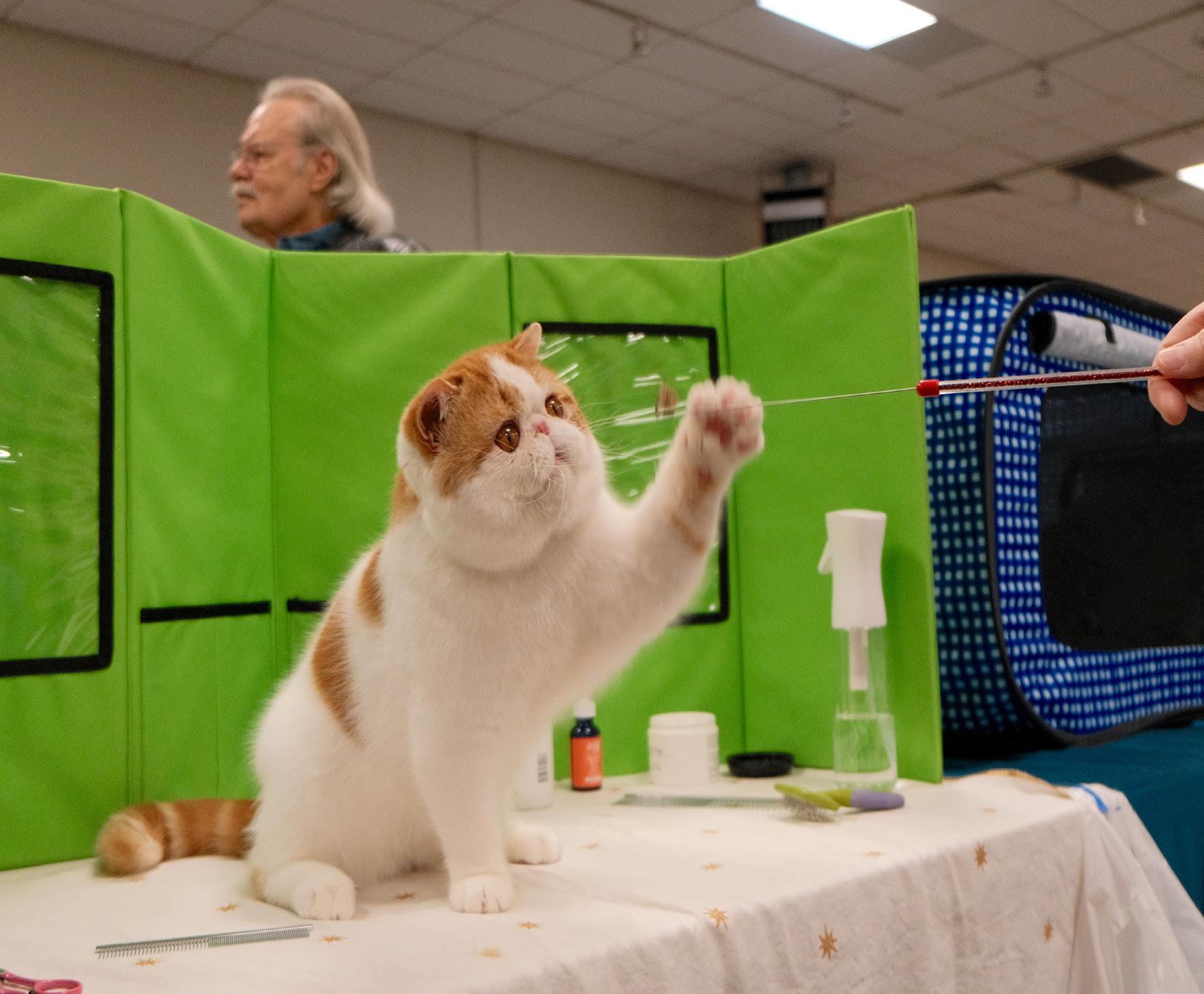
BY MATTHEW MCELDOWNEY city@theaggie.org
The Cat Fanciers’ Association (CFA), established in 1906, hosted the 2025 Call of the Wild/Poppy State Cat Club at the Yolo County Fairgrounds on Feb. 15. Competitors from all over the American Northwest brought their cats to be examined by a panel of the CFA’s ofcial judges.
Te CFA held three competitions for pedigreed, household pet and agile cats with over a hundred registered cats vying for prize ribbons and association recognition.
CFA judges evaluate the pedigree of cats based on the association’s approved standards per breed and their competition placements: the kitten competition, the championship competition and the premiership competition. A big winner at this year’s competition was Dude, a Persian shorthair who earned the prestigious honor of Best Kitten of the entire event.
Te competitor kittens are aged four to eight months and may advance to
the championship or premiership adult competitions. Both adult competitions are deemed as CFA standard; However, championship class cats are able to participate in certain breeding programs.
Ten, there is the household pet cats competition, which may not be of CFA pedigree standard but are nonetheless allowed to compete with their refned fufness and charming personalities. Lastly, all types of feline athletes are able to participate in the agility competition where they are evaluated in a timed, enclosed obstacle course. Further details and photos of all the event’s top cats can be accessed via the CFA website.
Te CFA hosts many cat shows like the Poppy State Cat Club shows throughout the year which offer spectators the opportunity to meet these cats more personally. With permission from the cat’s exhibitors, spectators are allowed to pet and take photos with the competing cats; Tough for cat lovers looking to fnd a new furry companion, the event also invited Super Fur-iends Rescue.
As a non-proft rescue operating
in Solano County, Super Fur-iends specializes in the care of feral, disabled and senior cats.
“Our mission is [...] to foster and adopt out animals that are often overlooked,” Super Fur-iends’ mission statement reads.
Te rescue is still currently adopting out some of their loveable cats on their website for those able and willing to provide them the special care they deserve. In addition, per Super Furiends’ mission to improve access to care for feral and tame cats alike, the rescue also ofers afordable spay and neuter services for cat owners to reach through their website.
CFA’s Poppy State Cat Club judge, Dennis Ganoe, refected on the programs and outreach of the association. With programs on their website for youth to get involved by setting up cat shows, conducting therapy cat visits and more through their Junior Fancier program.
“The CFA have been thinking of more ways to get younger people involved,” Ganoe said.
The virtual meeting presented information about resources and programs provided by the DA BY YUENJO FAN city@theaggie.org
On Feb. 11, the Yolo County District Attorney (DA)’s Ofce hosted their Commons Town Hall Meeting to provide insight to community members about the DA’s outreach e the frst town hall was held in 2021, the meetings have occurred on the second Tuesday of each month. Hosted by Sacramento attorney Marcus Wiggins, the Commons Town Hall touched on Yolo County’s data transparency dashboard, Restorative Justice Partnership (RJP) and youth outreach.
“Our Commons Town Hall is about real data, real talk and real change,” Wiggins said. “Tis is the chance for you, the public, to engage with policymakers, discuss community issues, see real and transparent criminal justice data and promote real change in our criminal justice system.”
Alongside Wiggins were three town hall panelists: Yolo County Chief Deputy DA Melinda Aiello, Restorative Justice Partnership Manager Nicole Kirkaldy and Yolo County Deputy DA Diane Ortiz. Each member of the DA’s Ofce brought forth a type of outreach while also describing how they help uphold criminal justice within Yolo County. Aiello, who holds over 28 years of prosecuting experience, introduced the Data Transparency Portal, a website that provides updated statistics about court cases, ofense types and other relevant pieces of information regarding criminal prosecution in the county.
of cases and by our law enforcement agencies. [The Data Transparency Portal] is something that we continue to review and evaluate. We look at the data and if we see some trends or concerns about how things are going. We look into whether or not we need to create
program’s steps to implement this newer form of criminal justice.
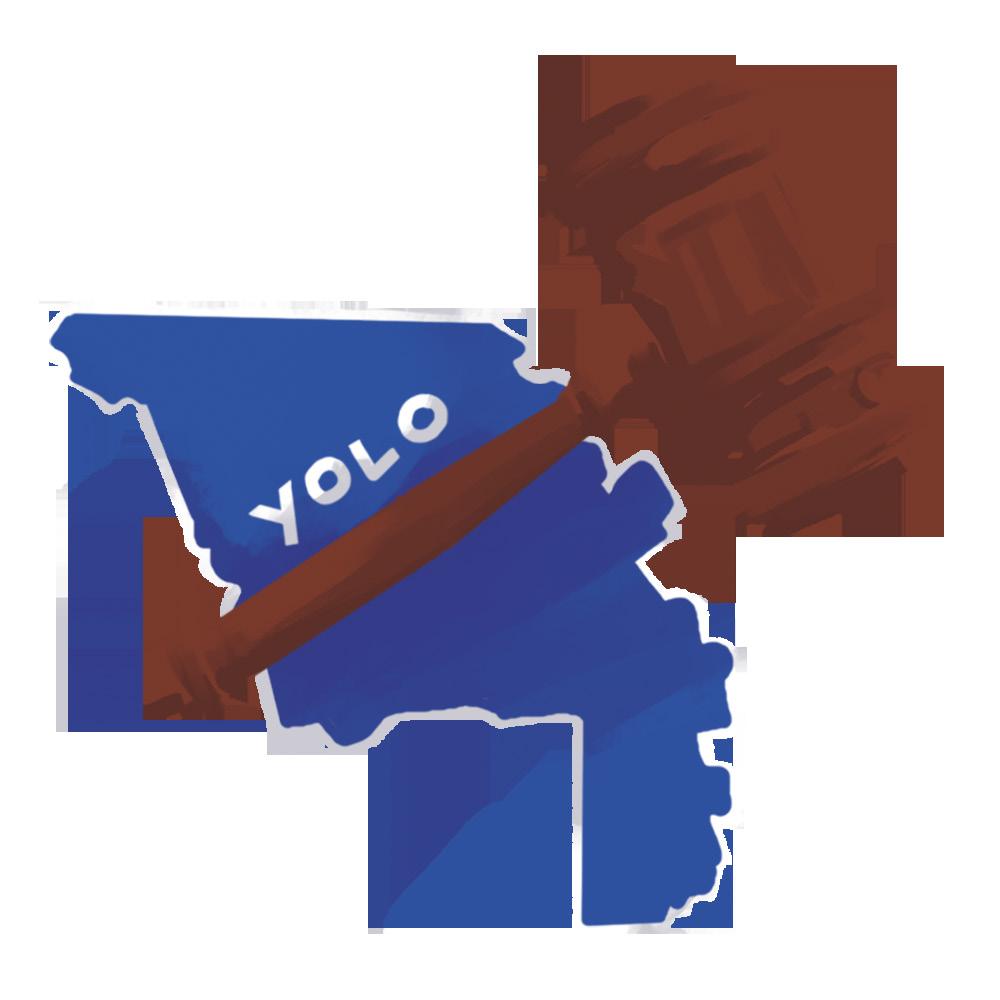
In collaboration with Thriving Pink, all event proceeds went toward supporting community members impacted by breast BY PIPER AWEEKA city@theaggie.org
On Saturday, Feb. 15, the 6th annual Davis Firefghters Crab Feast was held at the Davis Veterans Memorial Center. Food was served at 5 p.m. and dancing followed after. With 100% of ticket profts going toward Triving Pink, a local non-proft serving members of the community impacted by breast cancer, the feast included Dungeness crab, spaghetti, salad and a variety of drinks.
Matt Galloway, the battalion chief of the Davis Fire Department, was tasked with delegating work to volunteers. Having 21 years of experience within the Davis Fire Department, Galloway has been in charge of the event since its creation.
“Organizing an event this big, for the frst couple of years we did everything ourselves,” Galloway said. “Now, we use Kappa Kappa Gamma [and] all of our union members, and my mom and dad actually help. [...] My mom runs the kitchen, and I organize the event.”
Crab being an unusual choice given Davis’ inland location, Galloway elaborated on the origins of the event and the involvement of Triving Pink.
“To tell you the truth, my union president at the time asked me if I wanted to throw a crab feast, and I was looking for a little bit more responsibility in the union,” Galloway said. “We throw the event and Triving Pink does a rafe here. [...] it’s been a great way for us to contribute to local women going through breast cancer treatments.”
Leslie Hunter, the executive director of Triving Pink, shared the
organization’s purpose.
“Our mission is to support anyone in Yolo County who has been impacted by breast cancer,” Hunter said. “We help survivors from the time of diagnosis well into survivorship. We ofer Zoom workshops, in-person support groups, educational meetings, monthly walks, crafting, peer-to-peer mentors and fnancial grants.”
Thriving Pink was established in 2016. Hunter elaborated on the birth of the Crab Feast event from her organization’s perspective.
“At the time, we were doing a lot of awareness for breast cancer and health issues in the community,” Hunter said. Te frefghters wanted to partner with us on that mission and asked us to put on the annual Crab Feast with them.”
Perhaps most impressive is the event’s popularity. In the frst six years of its existence, tickets continually sold out days before the event. Galloway wrapped up by highlighting the popularity of the Crab Feast amongst the community and the resulting success in fundraising.
“It’s a huge community-involvement event,” Galloway said. “We’ve got the Davis frefghters, a lot of local political fgures, city council members, the mayor and people from Triving Pink. Together, we raised, I think, about $90,000 over the last seven years.” Amanda Ralston, the president of UC Davis Kappa Kappa Gamma, highlighted her sorority’s longstanding involvement and enthusiasm surrounding volunteering for the event.
“We’ve really enjoyed working with the frefghters the past three years,” Ralston said. “It’s really special because they also do it with Triving Pink, who we have done other community service events with. [...] Also, it’s awesome to just support women.”

Screenings of two films highlight legal battles and personal defiance against the executive order during World War II
“We have a commitment to our constituents to provide transparency,” Aiello said. “Te portal provides really critical information about what’s happening in our county and what’s happening to cases that get referred to us. We break it down by various types
the gap between the county and its residents.
Furthermore, the town hall touched on restorative justice, an alternate form of approaching criminal justice.
Trough her 11 years of experience at the ofce, Kirkaldy now oversees how this program can help bring change to the county.
“[Restorative justice] asks you to shift the focus from violation of laws and rules that we have in place to looking at the damage that crime causes to relationships in our community,”
Kirkaldy said. “In shifting that focus, we [change] how that crime or ofense gets addressed.” Kirkaldy also explained the RJP
“RJP uses a three-step conference model where we focus on building a sense of accountability and responsibility for the crime that occurred, the harm that happened and reaching that place with the person who’s caused harm,” en, we facilitate a discussion on the impacts of ense with members of the community [...] and then seek a restorative outcome.” e RJP program, currently seeking volunteer applicants, will hold a virtual training about restorative justice values on March 1 with more details online.
To close off the Commons Town Hall Meeting, Ortiz shed light on how fce is seeking to include young people in criminal justice. Named the Youth Leadership Academy, the DA-sponsored program is meant to provide youth with opportunities to work alongside members of Yolo County’s criminal Te academy is a three-day, back-to-back program open to high school students and can be used to earn community service
“It gives an opportunity for our youth to engage and have conversations with not only law enforcement but also big players and infuential people in our community,” Ortiz said. “[We do this] so that our youth understand that they do have a voice and there are people and adults that are ready to listen to them.
[...] As we’re working with the youth, every day they get an opportunity to meet with someone that might have a career interest that they have or someone that might relate to them on many diferent levels.”
Te next Commons Town Hall will be hosted on March 11. More information can be found on the Yolo County District Attorney’s Office website.

BY ALMA CULVERWELL city@theaggie.org
The city of Davis recently cosponsored a free event along with the city’s Human Relations Commission and many other local organizations for the Yolo County Day of Remembrance of Executive Order 9066 on Wednesday, Feb. 19 at Veterans Memorial Teatre. Executive Order 9066, signed by United States President Franklin Roosevelt during World War II, authorized the forced removal of Japanese Americans from the West Coast and relocation to internment camps, uprooting thousands from their homes and livelihoods.
The event featured two documentary f lms, “One Fighting Irishman” and “Row Don’t Drift,” which both document the resistance to the internment of Japanese Americans during World War II.
“One Fighting Irishman” is a flm that depicts the eforts of San Francisco civil rights attorney Wayne M. Collins in defending the constitutional rights of Japanese Americans during and after World War II. Collins spent 23 years representing more than 5,000 Japanese Americans who renounced their U.S. citizenship while imprisoned at the Tule Lake Segregation Center, which is considered the most oppressive of America’s wartime incarceration camps.
“Row Don’t Drift” tells the story of Yoshi Kubo, a birthright American
citizen forcibly evicted from his California farm under the World War II Japanese exclusion order and sent to an internment camp in Colorado. Trough interviews, archival footage and re-enactments, the flm captures Kubo’s fight against injustice, his family’s resilience and the unexpected kindness of neighbors who safeguarded his land until his return.
Pattie Fong, the event’s lead organizer, explained the process of selecting these movies and the powerful messages associated with them.
“Both movies recognize the Japanese community’s resistance to injustice and the goodness of people outside the Japanese community to help them,” Fong said. “Tis is very in line with our current political situation — a government very much out of control which targets and is harming specifc communities — all with the same justi f cation: ‘ T ey are taking away jobs and competing with white America.’”
Fong further described the flms.
“Both films show the anguish and trauma inficted on the Japanese families by the incarceration — the ‘internment’ totally stressed the Japanese American families — they fought over what it meant to be loyal, what was the best for the family, they were powerless,” Fong said. “It wrecked familial relationships even to this day.”
new subunit to support, partially integrate with Aggie House at Feb. 20 meeting
Vital Emergency Shelter and Transitional Assistance to support Aggie House’ facility and operational costs by establishing a new shelter at Russell Park
BY VINCE BASADA campus@theaggie.org
Te ASUCD Senate created a new subunit Tursday, Feb. 20, to expand transitional housing options for students in collaboration with Aggie House. ASUCD President Gaius Ilupeju also announced that ASUCD would begin renting a property at Russell Park to serve as a new transitional housing shelter in pursuit of this goal.
Te Vital Emergency Shelter and Transitional Assistance (VESTA), a nod to the Roman goddess of the hearth and home, will be responsible for the budget of the Russell Park facility and will be tasked with collecting data on the causes of housing loss for UC Davis students and the outcomes of ASUCD advising.
It is a subdivision of the Housing Advising for Undergraduate Students (HAUS) unit, which largely focuses on connecting students to existing housing options.
“I hope we bring into the conversation what ASUCD could show other student governments is possible,” Christina Smith, a fourth-year political science — public service major and the chair of ASUCD’s Housing and Transportation Advocacy Committee (HTAC), said. “We are leading the forefront here with this charge.”
Aggie House, the celebrated transitional shelter for and managed by students, was created in 2021 by former ASUCD commissioners. It has served over 70 residents since opening and has served as a model for similar shelters at UC Los Angeles, University of Southern California and several other college campuses.
Te foundation and core values of Aggie House have always been inclusivity and collaboration,” Emely Marroquin, a fourth-year neurobiology, physiology and behavior major and an Aggie House internal co-president, said at the meeting. “We’re so excited to have the opportunity to work with ASUCD and broaden our impact, not only through the capabilities of being able to house more residents but also by expanding our volunteer base.”
Additionally, VESTA’s creation and the Russell Park location will help relieve some of the shelter’s issues with fnancial reliance on grants, spatial
constraints and lack of a permanent location, considering Aggie House has changed locations twice since its founding.
“Relying on grant funding has been extremely unstable for [us] and our eforts largely have focused on just trying to stay afoat and survive, rather than thrive,” Nikhi Sundarapandian, a fourth-year political science — public service major and an Aggie House external co-president, said. “We’re really looking forward to a potential collaboration.”
While HTAC and HAUS will both be involved with supporting and expanding Aggie House’s operations, Smith made it clear that ASUCD will still continue its own advocacy work.
“Our main thing is advocacy always,” Smith said. “We never want to have to do this work. Transitional shelters aren’t something that undergraduate students should have to worry about being involved with or going to.”
In a 2024 survey, 19% of UC Davis undergraduates reported that they were sometimes or often unable to pay their housing costs on time; 50% said that they had worried about being able to cover their housing costs.
VESTA was created under Senate Bill (SB) #55, which passed at the meeting unanimously and thereby partially integrated Aggie House with ASUCD. Senate Resolution #8 also passed, affirming the Senate’s commitment to allocate $80,000 to rent the Russell Park property for the 2025-26 academic year.
At the meeting, Ilupeju commented on housing and basic student needs becoming a new main focus of ASUCD in the future.

Executive director of Yolo County Housing shared information on upcoming improvements
BY OLIVIA HOKR city@theaggie.org
On Feb. 18, the Davis City Council held its bi-weekly meeting and Yolo County Housing (YCH) provided a presentation on its f veyear Strategic Plan. YCH aims to establish sustainable and a f ordable housing to those in Yolo County. YCH is federally funded through the United States Department of Housing and Urban Development and the State of California Department of Housing and Community Development.
YCH assists the community with f nding a f ordable housing through Housing Choice Vouchers, which is a federal program that assists low-income families in paying for single-family homes, public housing and more.
Ian Evans, the executive director of YCH, gave the presentation on the overview of the program and how YCH intends to expand its efectiveness. Te Strategic Plan has been in the works for nine months and has received feedback from staf, public housing residents, city managers and housing commissioners, among others.
The Strategic Plan is built on three pillars: people, housing and administration. Each of those pillars also has goals, objectives and tactics. Te pillars and goals will be reviewed
every four to f ve years for a new strategic planning cycle, while the tactics will be reviewed annually.
Evans highlighted a few of the goals from the plan during his presentation.
Te next goal under [the] people [pillar] is to strengthen community partnership,” Evans said. “So, our objective around this is to create cross-education opportunities between our team [YCH] and our community partners, and through those opportunities, we hope to learn about their mission, goals and strategies and share our mission, goals and strategies to create fve new collaborative partnerships.”
Evans provided an example of this from the past year, when YCH created a partnership with Meals on Wheels, a non-proft organization in Yolo County, to deliver weekly meals to the senior households at YCH migrant centers. Davis City Council Member Josh Chapman shared his appreciation for Evans’ dedication to improving the lives of our community members. Chapman also expressed interest in getting more involved with the program.
“What can the city of Davis do?” Chapman said. “What can we do as elected leaders in this community to help support Yolo County Housing? What does that relationship look like for you? We have examples of what we’re already doing, and we know it’s
not enough.”
Davis City Council Member Gloria Partida asked about those who are a part of the public housing program and whether they can be supported for a sustainable amount of time.
“Often, folks who have to move out of the [migrant] housing, some of them return to their homes in Mexico or wherever it is that they are coming from,” Partida said. “But some of them remain because they have kids here. And I often hear that it becomes difcult for those families who want to continue here in our school system, and they basically end up having to double up with other families or couch [surf] and things like that. Are they eligible for any of the voucher programs to help them move from the migrant housing into something that they can aford in town? Is there a way that YCH can help in that regard?”
Evans also shared that the waitlist for the vouchers currently has about 4,700 people on it, and they are planning to adjust the time that the waitlist opens to make it more efective for those who really need it. Te presentation given by Evans is available to the public on the city of Davis website. To learn more about the Yolo County Housing resources available to community members, visit www.ych.ca.gov/.
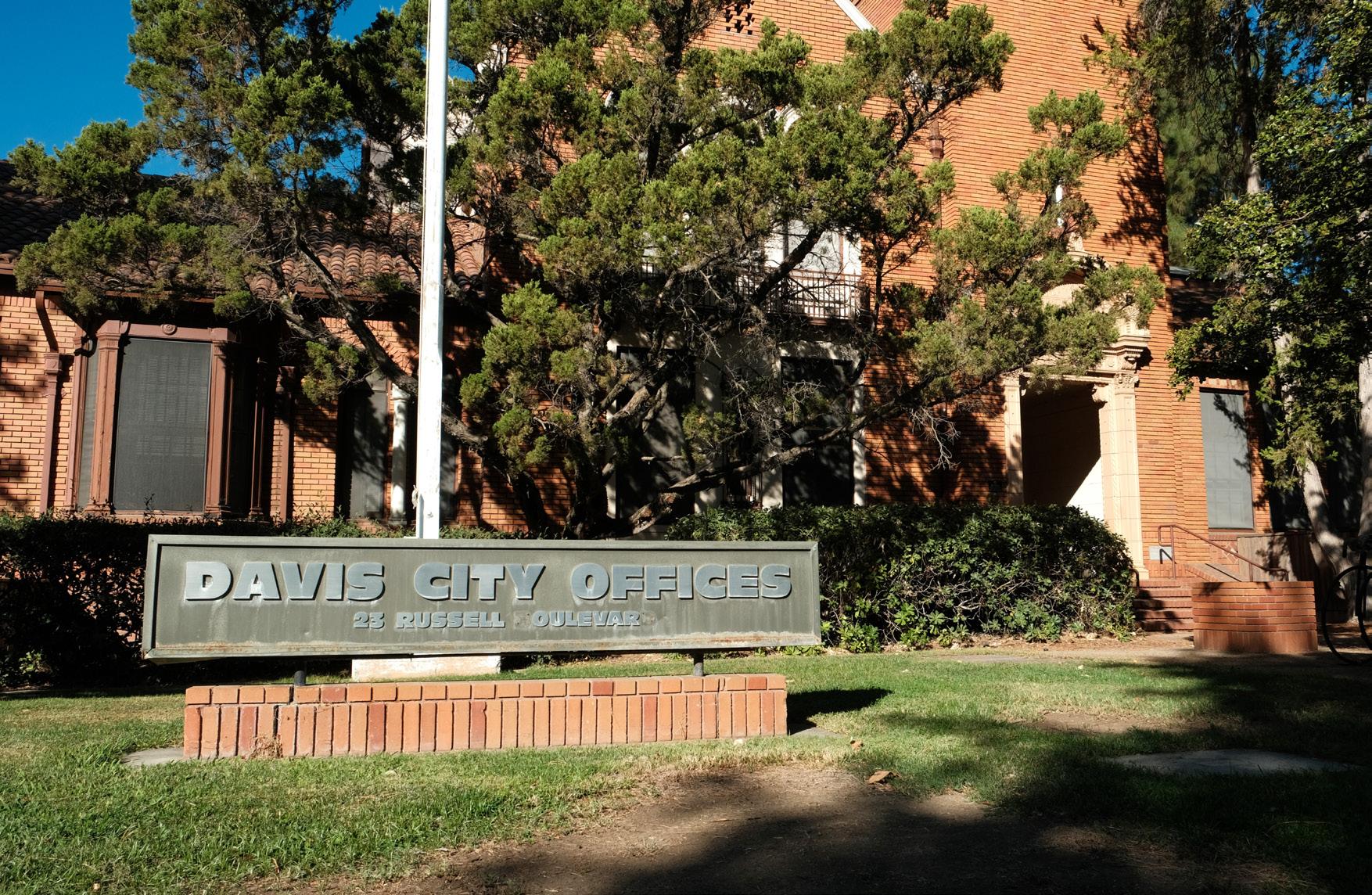
The event covered how immigrants could assert their rights in the presence of ICE or the police BY RORY CONLON city@theaggie.org
Te Yolo Interfaith Immigration Network hosted a workshop to help immigrants understand their legal rights when interacting with immigration agents and police at the Davis United Methodist Church on Feb. 19. If immigrants are stopped out in public by Immigration and Customs Enforcement (ICE) or the police, they have the right to remain silent. Amagda Perez, a co-director of the UC Davis Immigration Law Clinic, said the goal is to avoid giving ofcers probable cause to arrest.
Te only way that any of us can be arrested or deported is if we provide probable cause to show that we’ve committed a crime or that we’re here without status,” Perez said. “Without answering any questions, we’re not contributing any information that could be used against us.” Perez said that people do not need to present their documents unless they are pulled over.
“All you have to do is present your driver’s license, your car registration and proof of insurance, because otherwise you get your car taken away,” Perez said. “But after that, you’re not required to give your name [or] answer any questions regarding your nationality, citizenship status or place of birth.”
If ICE agents visit a residence, people can exercise their right to remain silent and choose not to open the door.
Tey can also ask immigration agents to slip the warrant they have under the door or through the mail slip.
Alicia Rusoja, an assistant professor with the School of Education at UC Davis, said people should determine whether ICE agents come with a judicial warrant or an administrative warrant.
“A judicial warrant is one that ICE can use to enter your home — [that’s] the one that’s correct,” Rusoja said. “An administrative warrant is something ICE cannot use to enter your home. Most often, ICE comes with an administrative warrant, so you should become familiar with these and know the diference.”
If ICE tries to enter the home regardless, residents should call the hotline for the Sacramento Rapid Response Network at (916) 382-0256.
Tis line can also be used to report ICE activity in Sacramento or Yolo County and seek help for someone detained in the last 24 hours.
If people are taken into custody, they have the right to remain silent, and they should not sign any document until they have consulted with a lawyer.
While everyone has the right to an attorney, the government does not have to grant people one if they are in the middle of immigration proceedings.
Natalia Deeb-Sossa, a professor in
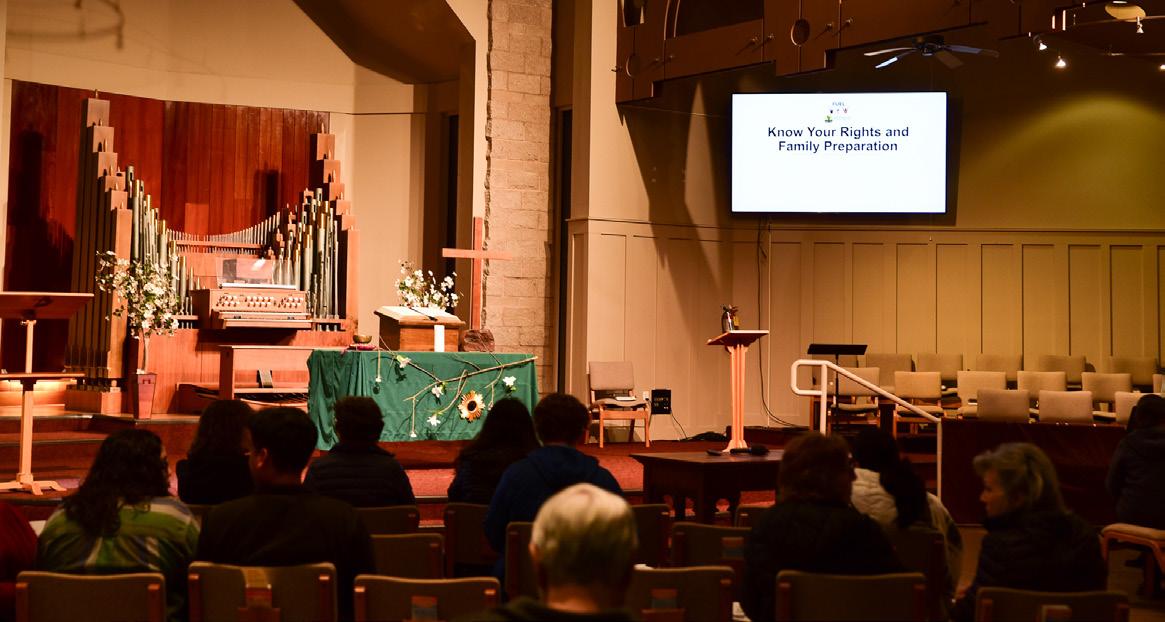
Chicano/a Studies at UC Davis, said people should know what public and private spaces are in a workplace and make sure they are well-designated.
“ICE can only have access to public spaces, not private spaces,” Deeb-Sossa said. “In a restaurant, [a public space is where] people who are eating sit, and in the back, where the cooks are, [that is a private space, and] they cannot go in there.”
The discussion turned to how schools are navigating interactions with ICE. Joana Peraza, a lawyer with the California Rural Legal Assistance Foundation, said that while local school districts have to cooperate with ICE, they can make it harder for them to enter schools.
“Right now, if ICE were to show up at a school in Sacramento County, they have a whole protocol where one, ICE has to come in with a valid warrant, and two, they cannot speak to the child,” Peraza said. “Tey have to go through either the superintendent of the district or some sort of legal counsel from the district.”
Perez said that UC Davis is still working on a policy for interacting with immigration enforcement, but it will likely be similar in structure.
“At the law school itself, they’ve implemented a policy that they’re not going to share any information, and they have a whole group of lawyers there deciding how the policy is going to be implemented,” Perez said. “Tey have to go speak with the dean, they’re going to consult with the campus council, they have to evaluate warrants to make sure they’re legitimate and then, if there is a court order, they will cooperate and release information.”
Deeb-Sossa said that she would not identify students to ICE, share whether they were in class or present their schedule.
“It’s about who the gatekeeper is,” Deeb-Sossa said. “Tell them: ‘Tis is a private classroom. You are not registered in my classroom. Get out of my classroom.’”
Students reflect on issues with commencement
UC Davis students and alumni discuss their worries surrounding commencement registration and the stress from previous years’ website crashing
BY EVELYN SANCHEZ features@theaggie.org
As spring approaches, it is nearly time for every graduating student, undergraduate and graduate alike, to walk across the stage during the commencement ceremony. Wrapping up years of intensive study, commencement fnally awards students with the certifcate of their name and degree built on all-nighters, stressful breakdowns and last-minute cramming.
However, one final breakdown UC Davis students might face rears its head at the last minute: commencement registration. Natalie Chrisman, a fourth-year human biology major who planned to walk in June, said she faced technical difculties while registering.
“I’m worried about registration, because when I tried to register to graduate, the website was down,” Chrisman said.
Chrisman commented that she attempted to register right as the application opened. Spring Commencement Registration opened on Feb. 25 for the spring 2025 graduation ceremony and offered three days for UC Davis’ large pool of graduating students. Possible dates include Friday, June 13 for either 9 a.m. or 2 p.m., Saturday, June 14 for 9 a.m. or 2 p.m., and Sunday, June 15, with only one session at 9 a.m.
Despite ofering a pool of selections, it is possible for students to fnd it difcult to accommodate other days if their frst choice isn’t available.
“I think everyone and their mother is trying to get Saturday commencement,” Chrisman said. “My parents have to take time of work, and I think it would be more of a hassle to do Friday.”
Perla Guzman, a fourth-year cinema and digital media and design double major who plans to graduate in the spring, commented on her graduation day preferences.
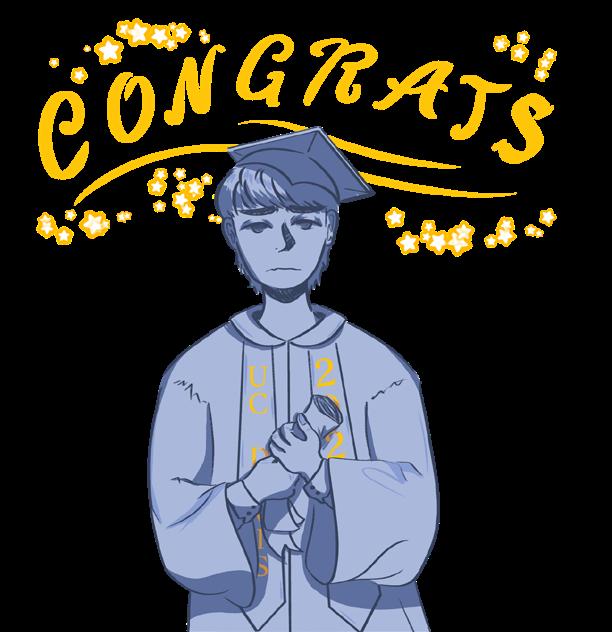
“I am trying to register for Saturday, at [any] of the times,” Guzman said. “I want this day because this is the day my sister preferred, but personally, I don’t have a preference. I just want to graduate.”
Analisa Haidinger, a spring 2024 alumna who graduated with a Bachelor of Science (B.S.) degree in sustainable environmental design, commented on her experience registering for spring commencement.
“My biggest worry was just not getting the day I wanted, which was Friday at 2 p.m.,” Haidinger said. “I ended up getting that [day], thankfully, since, I think, Friday is the leastdesirable day.”
Amanda Li, a fall 2024 alumna who graduated with a B.S. in biological sciences, commented about her difering experiences with registration.
“[Registering] was easy — there was no website crash and it was pretty straightforward,” Li said. “My only concern was being on the website too soon and it [not being] open yet.” Chrisman conveyed that, if she is unable to register for her preferred time, the lack of organization on the commencement website could result in an anticlimactic end to her four years.
“I’d feel really disappointed, because I feel like [graduation] is an achievement I’m proud of,” Chrisman said.
Finding meaningful experiences amongst life’s inherent limitations is easier said than done
BY JHANA RHODES jsrho@ucdavis.edu
I feel existential and have been this way for over two weeks. As I stood in front of one of the many towering bookshelves in Te Avid Reader
Bookstore, vibrant mosaics of books — from Edgar Allan Poe to Jenny Han — lined the shelves, their scent a blend of aged wood and dry ink. After contemplating whether I was spending the night with Shakespeare or Oscar Wilde, I reluctantly placed Hamlet inside my tote bag. As the checkout line inched forward, each step was further away from thousands of uncharted books and one step closer to the cashier, along with an inevitable realization: My desire to consume outweighs my capacity to do so. And it’s not just for books. Tere are millions of flms I haven’t seen, songs I haven’t listened to, places I’ve never been and people I’ve never met. Tough
I am only one person, I fnd myself increasingly frustrated at the thought of not accomplishing my limitless aspirations. While my existential conundrum highlights my personal struggle with actualization, it’s a feeling far from unique. Sylvia Plath poignantly captured this feeling: “I am gone quite mad with the knowledge of accepting the overwhelming number of things I can never know, places I can never go, and people I can never be.”
Plath’s quote encapsulates years of my existential angst into one sentence, beautifully summing up the human experience and the desire to experience limitless possibilities. Our world is full of uniqueness, beauty and rich and diverse culture, and therefore, it is only natural to want to experience everything life has to ofer. But alas, there are inherent limits. To clarify, I don’t want to live forever. I learned from Edward Cullen — the brooding, sparkling vampire — that immortality sucks, literally. If
I were stuck at 17 for over a hundred years, I’d be mad, too. However, the intrigue of immortality is still there. With unlimited time, I’d be able to earn every doctorate degree, be a master of all trades and maybe even read all of the 62 million (and counting) pages of Wikipedia. If I had all of the time in the world, perhaps I’d have time to explore everything life ofers. However, if I had the opportunity to do everything, how much of it would I appreciate? With hard work and determination, anyone can accomplish any goal they set their mind to. Tough I’m sure we all join student clubs and associations we are passionate about, it’s important to create meaningful goals rather than superfcial ones, such as joining a club on campus solely for the status or perceived resume boost. Tough the experience is excellent, you’d be able to appreciate it more if you had a genuine interest in the club’s activities. Ultimately, although it perturbs me that I won’t be around to witness
Exploring drag’s history of resistance and how it inspires us right now
BY TARA ROMERO
tcrome@ucdavis.edu
Drag is so much more than the new season of RuPaul’s Drag Race (however, Onya Nerve, a writer for Te California Aggie is rooting for you). Drag is queer expression. Drag is gender. Drag is racial identity. Drag is art. Drag is loud, and drag refuses to be silenced.
On Feb. 7, Sasha Velour, an esteemed gender-fuid drag queen, came to our very own campus to give a lecture on their new book, “Te Big Reveal: An Illustrated Manifesto of Drag,” blessing us with a Lypsinkaesque performance. In Velour’s lecture, they broke down the history of drag and why it’s relevant today.
What stood out to me most from Velour’s excellent critical analysis of drag ended up being the free forum portion of the evening, in which members of the UC Davis community were able to share their feelings. In response to Donald Trump’s presidency and our country’s shift to conservative legislature and enactments, UC Davis students and the Davis LGBTQIA+ community are feeling anxious and unsure about our country’s future and our own safety.
Since returning to ofce, Trump has enacted overreaching executive orders to discriminate against transgender people across America. On his frst day in ofce, he enacted an order that makes the United States only “recognize two sexes, male and female. Tese sexes are not changeable and are grounded in fundamental and incontrovertible reality.” In enacting this entirely socially established binary, Trump essentially discredits transgender, intersex, non-binary and gender-fuid identities.
From an executive order on Jan. 28, the United States will no longer “fund, sponsor, promote, assist, or support” any person’s gender-afrming medical care if they are under 19. Hospitals across the country have already begun to halt gender-afrming care for transgender children, according to an article from the American Civil Liberties Union (ACLU).
It’s no surprise that our community is feeling anxious and unsure when our government is so openly discriminating against our bodies and our identities.
Te Trump administration wants us to be scared and hide ourselves. It wants children to live in bodies that don’t feel like their own. It wants us to not live as ourselves and instead wants us to assimilate to an imaginary standard of what our gender “should be.” Drag is the antithesis of what the conservatives want queer and trans people to be. Drag expresses queerness and gender in abundance. Drag artists live their identities to the fullest
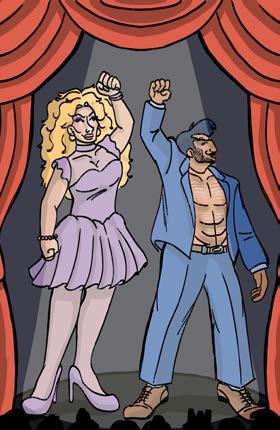
extent, and their performances serve as inspiration within their communities.
Te history of drag is rich and complex, existing across many cultures. Author Simon Doonan explained how drag dates back to classic Greek and Roman theater. Drag has also notably made its mark on the English Shakespearean stages, Japanese Kabuki theater and Chinese Peking opera — all before the 19th century. In the U.S., the art of drag has always been an act of resistance. Troughout the 19th and 20th centuries, police raided gay and lesbian bars to crack down on “sexual indecency.” Te frst person to call themselves a “queen of drag” was William Dorsey Swann, a formerly enslaved Black person who held private drag events with other Black drag artists and was arrested in 1888 during a “drag raid.” After decades of police raids, Black and Latina trans women and drag artists, like Marsha P. Johnson, Sylvia Rivera, Stormé DeLarverie and Miss Major GrifnGracy, led the Stonewall Uprising in 1969 — a historic symbol of queer resistance.
During the acquired immunodefciency syndrome (AIDS)
epidemic in the 1980s, drag queens would organize fundraisers and educate the community on AIDS. Black drag queens, like Bob the Drag Queen and Jo Mama, were vocal and involved in the Black Lives Matter protests in 2020. Right now, in Sacramento, a local group of drag artists is holding Drag Benefts for Gaza.
Alongside the U.S. government’s long history of policing queer people and the bodies and forms of expression of Black, Indigenous and people of color (BIPOC), there has always been a long history of drag artists’ resistance to go with it.
For every member of the Davis community who is feeling anxious and unsure right now — do not hide yourself. Do not let your voice be silenced. Express yourself how you want to express yourself. Protest for your rights and your community’s rights. And, remember: You’ve always got a drag queen in your corner.
Disclaimer: Te views and opinions expressed by individual columnists belong to the columnists alone and do not necessarily indicate the views and opinions held by Te California Aggie.
all the newest flms, songs and literature available hundreds of years from now, I accept that my time is fnite. It’s bittersweet — I can’t do or be everywhere all at once. Tis limitation makes my limited experiences that much more meaningful. I’m still learning to worry less about all of the paths I have not taken, and instead, I’m learning to appreciate the path I’m currently on. In the meantime, I’m happy watching my little sister grow up into an outstanding adult, walking around the neighborhood with my mom or talking about anything and everything with my grandma. I am beyond grateful for all the memories I experienced in the past, the opportunities in the present and the

TRAN /
adventures to come in the future.
Disclaimer: Te views and opinions expressed by individual columnists belong to the columnists alone and do not necessarily indicate the views and opinions held by Te California Aggie.
Bootcut jeans are a bold choice, eh?
BY NEVAEH KARRAKER nakarraker@ucdavis.edu
Te ignition of a revolution is near:
Tere’s a demand for justice and a cry for change, and Kendrick Lamar holds the power of unity within his grasp. His artistry is more than just songs — it’s a refection of the complexities of identity and politics.
Each lyric, song and album is layered with rich symbolism and purpose. Kendrick’s album “To Pimp a Butterfy” acts as a testament to this, standing as a documentation of a rite of passage: an exploration of self discovery, internal confict and discrimination.
Tis renowned album, along with the rest of his work, represents a paradox: Despite being criticized and undermined by the industry, Kendrick remains unfaltering in his beliefs and heritage. He aims to reinforce pride in African American culture for what it truly is and to demonstrate that it is not a trend to be exploited for popularity. It’s this quality that allows him to rise above the status quo and perfect his craft. Trough the use of unconventional techniques, he produces both captivating and thought-provoking music. After all, not many people can get a full stadium to chant an insult toward another celebrity. Tat’s Kendrick’s masterful ability; He doesn’t just make music to listen to, he challenges the norm, stirs the crowd and, somehow, also pleases the ear.
Tis distinctive trait extends beyond serving to challenge the music industry. He directly calls out institutions, artists and the system at large in an unmistakable manner. Kendrick highly values authenticity; He avoids plagiarism yet is also unafraid to express controversial themes.
His recent Super Bowl performance, for example, represented far more than a mere routine stage appearance. It was a calculated opportunity to send a powerful message to millions of viewers — to force listeners to confront the imminent, unacknowledged conficts in America.
In this way, Kendrick uses his platform for advocacy and awareness. In particular, he highlights how our social system generates rampant political division. He also calls out how it unfairly exalts the rich, pushing the nation into a further state of poverty and unemployment.
Te setup of a PlayStation controller and a split American fag is an example of this unfltered, transparent statement. By collaborating with other Black artists like SZA, DJ Mustard and the Turfenz Dance Crew, Kendrick paves the road to amplify the voices of those desiring change.
Moreover, in dissing his “opps” on live television, Kendrick wasn’t
The eggheads have been infected by the bird
How will this impact my daily omelet?
BY ALLISON KELEHER adkeleher@ucdavis.edu
Late one night, I left the library around closing time (since I am a nerd), and I noticed something peculiar in the distance. Looking toward Mrak Hall, I saw a team of doctors in hazmat suits rushing toward the Eye on Mrak egghead. Tey sprung into action and quickly set up a quarantine tent around the egghead. Even more weirdly, the doctors then assumed their places at each corner of the tent. I took my glasses of to rub out a little smudge, and then I went home.
Te next day, the campus was buzzing about the quarantine tents: Tey were set up around each and every egghead on campus. Some brave students attempted to approach the doctors for more information, but a loud siren noise would go of if anyone
got within six feet of the tent.
“Tey won’t tell me anything either,” Chancellor Gary May whined when asked for a statement.
Apparently, this whole operation is bigger than we will ever know. Some students are really worried about this, but my nonchalant nature doesn’t allow for that.
I strolled over to my economics lecture and took a seat. As my professor started talking about supply and demand, he referenced the current supply shortage of eggs due to the avian infuenza, or the bird fu. Ten, my professor let out a little giggle and said: “Although we won’t have to worry about that now…”
Tis was suspicious, because people with doctorates in economics shouldn’t be giggling over people not being able to aford breakfast. Luckily, I didn’t need to say anything because my classmate asked, “What does that mean, professor?”
“I’ve said too much!” my professor exclaimed. Ten, he abruptly ended the lecture and rushed out of the hall. I decided to follow him since I had nothing better to do. He went straight to the Stargazer egghead and, surprisingly, the alarm didn’t go of for him. Te doctors pulled open the tent faps to let him through, abruptly closing them afterward. Since I couldn’t see inside the tent, I decided to linger on a nearby bench. When my professor eventually emerged, he was carrying a large syringe full of what looked like egg whites. He tucked it under his trench coat and rushed of toward his lab. Luckily, I had already been stalking his lab in an attempt to get hired, so I knew exactly where to go. In fact, I made it there before my professor did. I watched through the windows as he started running tests on the egg white goo from the syringe.
After what felt like hours, my professor left his lab with a wide smile on his face. Unfortunately, he ran into

just throwing punches, he was conquering the very forces that sought to censor him. Samuel L. Jackson’s eerie portrayal as Uncle Sam exposes this censorship and opposition to spirited outbursts, emphasizing how people often refuse to pay attention to opposing opinions. Te look of triumph Kendrick wore during the performance expressed satisfaction in defeating rivals as well as the system itself — and, even more signifcantly, by profting of of it.
After all, Kendrick is the epitome of transforming struggle into success. From growing up in Compton, a city overrun with crime, to becoming one of the most infuential rap artists of our modern world, Kendrick projects something greater than music — dedication and perseverance.
Clearly, every decision Kendrick makes carries immense signifcance, even in the smallest details. His fashion choice for the Super Bowl, like the complimentary bootcut jeans, is a blunt reference to the counterculture movement of the 1960s. Tis, along with his “a” chain — whether to ofend artists or represent his multimedia company “pgLang” — is subtle. Tese seemingly random choices play an efective role in a larger narrative. When it comes down to it, Kendrick rejects partisan labels, taking an uncommon stance to convey a deeper truth: Te problem is not the right side or the left side but in the very system that implements that divide — the illusion that choice gives us control. In reality, change will remain impossible unless the American people unite, regardless of race or, most importantly, political beliefs.
Maybe the people who dislike his music happen to be the ones who need to hear his message the most. After all, Kendrick pushes the boundaries for all, regardless of whether one understands or is willing to listen.
So tell me, is this really a game? Or are we all players in a system that Kendrick’s art is trying to caution and help us break free from?
Disclaimer: Te views and opinions expressed by individual columnists belong to the columnists alone and do not necessarily indicate the views and opinions held by Te California Aggie.

me hiding in the bush outside. Since my cover was blown, I said, “I have a quick question from today’s lecture.”
“Ma’am, it’s 9 p.m.” I ignored the fact that he called me “ma’am” and started to follow him as he walked away with a pep in his step. “What are you doing to the eggheads?” I asked, for investigative journalism purposes. “You mean what are the eggheads
doing for us?” he countered maniacally. I honestly had no idea what this could mean. I didn’t even realize there was goo inside of the eggheads. While I was pondering these thoughts in my head, my professor vanished into the night air. I didn’t see him again for the rest of the quarter. A month or so later, balance had been restored on campus and the doctors left. Everyone seemed to collectively forget about the weird egghead incident in February. Tat was until swarms of paparazzi made their way onto campus and surrounded the eggheads. Flashes of light blinded the poor eggs, who couldn’t consent to having their picture taken. My professor was at the front of the mob, seemingly directing the paparazzi to the best angles for taking photos. Later that day, I got a notifcation for a news article titled, “Te Avian Flu is Over.” When I opened the link, I saw a large image of my professor smiling over an egg.
EGGHEADFLU on 9
What hasn’t the Trump administration done?
WRITTEN BY THE
EDITORIAL BOARD
Tis week marks the one-month anniversary of President Donald Trump’s return to power, with a new and fascist-aligning administration. Within a month of assuming ofce, Trump has signed 73 executive orders, with many more expected throughout his term. During this time, the Trump administration has implemented several dangerous and unconstitutional policies. While current news may feel more and more overwhelming everyday, we have an obligation to stay aware of these unprecedented orders and we must continue to condemn them as they arise.
Below is a summary of some key executive actions:
1. Hinting at an unconstitutional third term
In speeches dating back to 2020, Trump has expressed his desire to potentially run for a third term, despite the 22nd Amendment limiting presidents to two terms — whether consecutive or non-consecutive.
“Should I run again? You tell me,” Trump said on Feb. 20, 2025 at a Black History Month event.
Tis was just one day after Trump referred to himself as “King” in a social media post, writing, “Long Live the King.” We need to take these threats to our democracy seriously — brushing of these claims is what allows a dictatorship to develop right in front of our eyes.
2. Detaining undocumented migrants at Guantanamo Bay
On Jan. 29, the administration
Correction: The Senate Report in the Feb.
Senate discusses then tables resolution to affirm protections for undocumented students at Feb. 13 meeting,” incorrectly named the Legislative Director who had written Senate Resolution #7. Their name is Chely Saens.
released plans to detain undocumented migrants at Guantanamo Bay, a naval base previously used as a military detention facility. Te facility gained notoriety during the George W. Bush administration for unethically detaining and interrogating suspected terrorists after the 9/11 attacks. Plans to house these migrants in tents at the center have since been suspended due to detention standards. However, as of Feb. 23, the Trump administration transported 17 more migrants to the center. Tis inhumane and blatantly racist treatment of migrants is part of an ongoing efort by the Trump administration to dehumanize and target Latino and immigrant communities.
3. Withdrawing the United States from the Paris Agreement and Paris Climate Accord
On Jan. 20, Trump signed Executive Order 14162, ofcially withdrawing the United States from the Paris Climate Accord. Te Paris Agreement, adopted in 2015, aims to combat greenhouse gas emissions and mitigate global warming worldwide. Te executive order, titled “Putting America First in International Environmental Agreements,” was issued just hours after Trump took ofce. Te U.S. previously left the Paris Agreement during Trump’s frst term (2017-2021) and later rejoined in 2021 under former President Joe Biden. Additionally, Trump has made misleading claims regarding climate change and its efects.
Te biggest threat is not global warming, where the ocean is going to rise one-eighth of an inch over the next 400 years, [...] and you’ll have more oceanfront property,” Trump said in an August press conference. However, his comment has no evidential support regarding the actual rate of sea level rise — with sea levels projected to rise much faster at a rate between 10 to 12 inches in the next 30 years — and his denial and mockery of climate change represents a concerning trajectory for the planet’s environmental well-being. Making a joke of this serious issue shows his blatant disregard for the environment and those who will be afected by climate change.
4. Suspension of foreign aid
On Jan. 20, Trump signed Executive Order 14169, halting all U.S. foreign development assistance programs for a 90-day review period.
While later exemptions were made for essential humanitarian aid, signifcant portions of U.S. foreign aid have been pulled back. Te executive order, titled “Reevaluating and Realigning United States Foreign Aid,” includes restrictions on aid programs established prior to Trump’s latest term.
Since its foundation in 1961, the United States Agency for International Development (USAID) has grown to be the largest provider of foreign assistance around the world. With its services halted, USAID no longer provides humanitarian resources to Ukraine in the face of continued Russian aggression. Programs that distribute vaccines for viruses like Ebola and polio, along with treatment for human immunodefciency virus (HIV) and food supplies for povertystricken areas have also ceased. Te crude disbanding of an international organization with this much infuence, which was developed over the course of more than 80 years, is a clear signal from Trump that no humanitarian efort is safe from scrutiny.
5. Imposition of tarifs on Canada, Mexico and China
On Jan. 31, the Trump administration announced the implementation of a 25% tarif on imports from Canada and Mexico, two long-time U.S. trade partners. An additional 10% tarif on all imports from China took efect on Feb. 4, 2025.
Tese tarifs do not and will not lead to a decrease in prices for everyday goods such as eggs, contrary to Trump’s assertions. A video of him stating that “groceries” is “sort of an old-fashioned word” only emphasizes his complete lack of understanding toward the daily lives of the majority of American citizens.
His blatant disregard for promises he made to the public, with him remarking that it’s “hard to bring things down once they’re up,” further shows that Trump has no intention to create a more afordable day-to-day lifestyle for citizens and used empty promises to secure the vote of the lower and middle classes.
Instead, these tarifs will make everything from fruits and vegetables to electronics signifcantly more expensive, since many of these products are produced by the aforementioned countries.
6. New cabinet appointments Trump appointed and confrmed
Editorial Board
CHRIS PONCE Editor-in-Chief
ALYSSA CREVOISERAT Managing Editor
MADISON PETERS Campus News Editor
HANNAH SCHRADER City News Editor
MAYA KORNYEYEVA Opinion Editor
ZOEY MORTAZAVI Features Editor
ANA BACH Arts & Culture Editor
MEGAN JOSEPH Sports Editor
KATIE HELLMAN Science Editor
Managing Staf
JENNA LEE Photo Director
ARIANA NOBLE Layout Director
LANHUI ZHEN Design Director
JOANNE SUN Social Media Manager
AARON POTTER Website Manager
CASSIDY GILLIS Distribution & Outreach Director
TIFFANY HE Copy Chief
JENNY DYE Copy Chief
SAMUEL RUIZ Translation Director
ILEANA MERAZ Translation Director
LAURIE PEDERSON Business Development Manager
new leaders for key positions in his administration, including Secretaries of State and Defense, as well as the Director of the Federal Bureau of Investigation (FBI). More confrmation hearings are expected in the coming weeks.
It has become abundantly clear that Trump selects his cabinet members based on loyalty and partisanship rather than on individual merit and qualifcation. Multiple new members of Trump’s cabinet are under public scrutiny for this perceived lack of qualifcation, including Robert F. Kennedy Jr., the recently implemented U.S. Department of Health and Human Services secretary and Pete
Hegseth, the newly confrmed secretary of the Department
Defense.

Do they hate you? Love you? A secret third thing?
BY MADISON SEEMAN meseeeman@ucdavis.edu
Nearly 30 minutes into my threehour-long computer lab, I felt a strong disturbance in the vibes. Something was boring to me, strong enough to bypass all three layers of my incredibly cozy outft. It was the kind of ofputting feeling that can only mean one thing — someone was staring at me. You might think I was being a little self-obsessed. You might be shaking your head, thinking, “Maybe he’s not staring at you, Maddy! Maybe he’s tired and you’re in his line of sight.” However, an overthinker’s intuition is never wrong; Te moment I turned to check if he was staring, he whipped his head away. Guilty. As. Charged.
We’ve all been there — and if you haven’t, count your lucky stars. It’s exhausting to have to wonder what that stare might mean. Is my outft really that cute? Do we know each other? Have I been walking around with red paint on my face all day? All of these have been true for me at one point or another.
But, how do you fgure out what you have done to deserve the space you’re taking up in their mind? Or whether they are even thinking of you at all? Tere’s a science to it, and I consider myself a bit of an expert. Lucky for you all, I’m also willing to share! It’s an intricate process, but each cue gives you a piece to the puzzle.
To start, pay attention to the length of the stare. Have they been looking for a while? Are they stealing
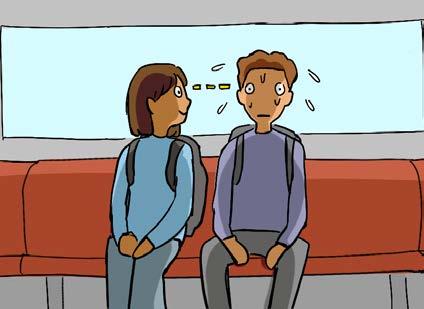
anything less and they could just be bored.
Facial expressions are another crucial clue. Consider mouth shape. Tere’s nothing more of-putting than someone staring
indicative of devious and evil intentions. Finally, a blank face is just the worst, because that could really mean anything. You wouldn’t think to look at their hand shape, but next time you fnd yourself on the end of a mighty gaze, take a stab at it! If their fst is clenched, it’s a sure sign they’re possessed by something — whether that’s passion for you or something a bit more sinister.
Tere are lucky, lucky people out there who walk around with horse blinders, oblivious to any attention they draw. But, be proud.
Tere’s strength in being paranoid and devoting precious class time to interpreting the signs being broadcasted at you.
So, whenever you start to feel the tell-tale signs of having caught the attention of someone with a staring problem, stop. Consider these factors. And jump to conclusions.
Disclaimer:
The event consisted of vendors selling vinyl, DVDs and CDs at a lower price

BY AALIYAH ESPAÑOL-RIVAS arts@theaggie.org
On Feb. 22, Armadillo Music invited physical media enthusiasts to Dunloe Brewing for Vinyl Apocalypse, an event where guests could peruse boxes and crates of CDs, DVDs and vinyl priced at two for one dollar.
Te event ran from 11 a.m. to 5 p.m., with the media selections being rotated as hours went on, bringing out new pieces for people to examine. Te event is held every few months to help manage inventory, according to Armadillo Music’s General Manager, Paul Wilbur.
“We’ve done 10 of these events now,” Wilbur said. “Every day, CDs, records and DVDs come through our front door and there is no way we can put it all in our store. We buy more things of the street than most businesses that you can imagine, but it gets to a point [where] we can’t deal with all of it.”
Joselino De La Rosa, a secondyear human biology major, attended the event after hearing about it on the store’s Instagram page and described the setting of Vinyl Apocalypse.
“Nowadays CDs are so expensive, so when I heard they would be two for one dollar, I knew I had to come,” De La Rosa said. “I heard about the event through the Armadillo Music Instagram page, and I was shocked to see how many people came. I only got there 30 minutes after it started and it was packed.”
Students and community members alike entered the store in search of discounted physical media. Some shoppers weren’t aware of the event beforehand and found out while walking around Downtown Davis. Naima Montecinos, a fourth-year biochemistry major, stopped by the event after walking past it and thought it was a good deal.
“I was just walking to the farmers
market and happened to walk past the event and decided to go inside after hearing about the deal,” Montecinos said. “I have a CD and record player at home, so I’m always looking to grow my collection.”
Montecinos collects used physical media to reduce waste and support artists directly as opposed to streaming.
“I think collecting used media is a really cool way to reduce waste and learn more; Often, a pamphlet, lyric book or short biography accompanies a beloved physical album,” Montecinos said. “It is also important to me because collecting physical media supports the artists directly without a middleman like Spotify or Apple Music.”
For De La Rosa, he collects physical media for the deeper connection he feels when playing an album as opposed to listening on streaming services.
“I feel like having the physical version of an album gives you a deeper connection to the artist or song because you physically own it and decide to play it,” De La Rosa said.
“With streaming, there are algorithms that know your listening habits, so listening doesn’t feel as meaningful unlike choosing a specifc album to physically play.”
With the resurgence in popularity of physical media, Wilbur is optimistic that Armadillo Music can continue to host events like Vinyl Apocalypse.
Te event was a success, because people are getting back into collecting physical media,” Wilbur said. “People want to have a connection to the artists and the art, and by owning the physical copy of their music, it allows them to have that direct connection. We’re excited to continue to supply the Davis community.”
Check out the Armadillo Music Instagram account or website for more information on future events, and mark your calendars for the next Vinyl Apocalypse.
From farm to fork, there’s no wrong way to enjoy this berry delicious holiday
BY IQRA AHMAD
arts@theaggie.org
Happy National Strawberry Day! Every year on Feb. 27, strawberry lovers unite to celebrate one of the most beloved and versatile fruits.
Whether you enjoy them fresh, dipped in chocolate, blended into smoothies or baked into delicious treats, strawberries add a burst of favor and a pop of color to any dish. Teir natural sweetness, vibrant red hue and countless health benefts make them a true staple in kitchens worldwide.
But why stop at just eating strawberries? Don’t be straw-dinary, try something new. Tere are plenty of fun and creative ways to celebrate National Strawberry Day. From trying out new recipes to hosting a strawberry-themed party, this day is the perfect excuse to indulge in everything strawberry.
Make strawberry-themed recipes
One of the best ways to celebrate this day dedicated to strawberries is by making strawberry-inspired dishes.
Te possibilities are truly endless!
One delectable dessert to make is

BY ELIZABETH BUNT arts@theaggie.org



Book: “Te God of the Woods” by Liz Moore (2024)
Te God of the Woods” is perfect for fans of the mystery/thriller genre as well as anyone looking for their next page turner. Set in New York’s Adirondacks in 1975, it tells the story of 13-year-old Barbara Van Laar’s disappearance from summer camp. Her sudden disappearance mirrors the missing persons case of her older brother a decade earlier. Te novel spans generations as the reader slowly uncovers the ugly secrets of the Van Laar family. “Te God of the Woods” is an intricate mystery that doesn’t rely on cheap plot twists or scares to unsettle its readers. It has something for everyone, even those who are not typically fans of the thriller genre.
Album: “Reading, Writing and Arithmetic” by Te Sundays (1990)
“Reading, Writing and Arithmetic” is the debut studio album of English altrock band Te Sundays. It appeared on several Best Album lists including Pitchfork’s rankings of “Te 30 Best Dream Pop Albums” and “Te 25 Best Indie Pop Albums of the 1990s.” Te songs on this album are a showcase for lead singer Harriet Wheeler’s voice. Her uniquely expressive voice creates a dreamy vibe and adds another layer of sound to the already complex album. Tis is an album that can make listeners feel like the protagonist in an indie movie.
Movie: “Wildcat” dir. Ethan Hawke (2023)
Tis movie recommendation is directed toward all English majors and book lovers. “Wildcat” is director Ethan Hawke’s biopic of Flannery O’Connor. Starring his daughter, Maya Hawke, it blends the details of O’Connor’s life with the visualization of her short stories. Te stories become more and more prominent as O’Connor copes with her Lupus diagnosis. “Wildcat” also centers heavily on O’Connor’s relationship with her Catholic faith, themes of which bleed through all of her fction. Te Hawke pair does an amazing job adapting both O’Connor’s inner life and fction to the screen, and their work brings a new spotlight to one of the greats of American literature.
Song: “Motel 6” by River Whyless (2018)

River Whyless is an indie/folk band based in Asheville, North Carolina. Tey are known for their festival appearances at events like Newport Folk Festival and Bonnaroo as well as their NPR Tiny Desk Concert. Tis song comes from their 2018 album “Kindness, A Rebel” and was written by the band’s Ryan O’ Keefe. It tells the story of two people parting ways in a Motel 6 parking lot and the subsequent emotions of the narrator. Its sound is lilting and dreamy, foating from verse to verse. Te fnal line of the chorus, “From a dream / I’m waking up / and for the frst time / I’m terrifed of waking up alone,” drives the nostalgic heartache of the song home.


cheesecake-stufed strawberries, a simple yet decadent treat that requires just a few ingredients and a few minutes to prepare. If you’re in the mood for something with a classic touch, a strawberry shortcake is a perfect way to commemorate this holiday. Even breakfast can be strawberry-themed. Imagine starting your day by whipping up some fufy strawberry pancakes, oatmeal topped with fresh berries or a strawberry smoothie.
Create a strawberry spa experience
Did you know strawberries are packed with antioxidants and vitamin C, making them a great natural ingredient for skincare? While eating them is the best way to get these nutrients, try a strawberry face mask or a strawberry sugar scrub for a refreshing at-home spa treatment and a fun step in your skincare routine.
Host a strawberry-themed party

Turn National Strawberry Day into a full-fedged celebration, gathering your friends and family for an evening flled with trying new treats and drinks. Set up a strawberry-tasting station, featuring diferent strawberry desserts like chocolate-covered strawberries, strawberry tartlets and strawberry shortcakes. You can even decorate with pink and red hues. It’s a fun and festive way to share your love for this fruit with others.
Visit a local strawberry farm Living in Davis means being near the heart of incredible agriculture, especially strawberry
Several Hollywood actors are returning to the West End stage this year
BY BETH MUNRO-MORRIS arts@theaggie.org
Actors often frst hone their craft on stage, where theater serves as a stepping stone toward a more lucrative career in flm. While the glamor of Hollywood may be the ultimate destination for some, not every actor is satisfed with a career spent in the spotlight of Los Angeles. In fact, some crave a break from the intense spotlight of film altogether. Actors are increasingly setting up base across the Atlantic, choosing to showcase their talents far from the camera lens.
The past year, theater has seen several big names return to their humble beginnings or make their debut on London’s West End stage. Here’s a look at just some of the actors who are proving that they can truly do it all:
Many Marvel fans flocked to London this summer to watch their favourite superhero return to the West End stage. Known predominantly for his iconic role as Peter Parker in the latest Spiderman series, Tom Holland starred as Romeo in a new adaptation of “Romeo and Juliet” at the Duke of York Teatre. Despite its localized display, the production gained the status of a global event, becoming a complete sellout months before its opening night on May 11.
However, Holland is not new to the West End stage. In fact, it was where he got his start. At just 12 years old, Holland starred as Billy Elliot in the iconic “Billy Elliot the Musical,” a role that launched his career. Returning for the frst time after 15 years, having cemented his place as both a flm and theater star, Holland’s performance as Romeo marked a full-circle moment for himself and fans.
From “Love Rosie” to her leading role in “Emily in Paris,” Lily Collins made her West End debut in the comedic drama “Barcelona.” Te production, which ran from October 2024 through early 2025, saw Collins leave behind her signature brown locks, opting for a blonde transformation where she played Irene — a painfully American real estate agent who’s vacationing in Spain.
Ironically, her character’s experience mirrors Collins’ own as an American abroad in a European city. What begins as an innocent one-night stand with a local Spaniard quickly escalates into a dangerous and tangled narrative. Teaming up with “Money Heist” star Pedro Alonso, the two-person show captivated the audience with its blend of
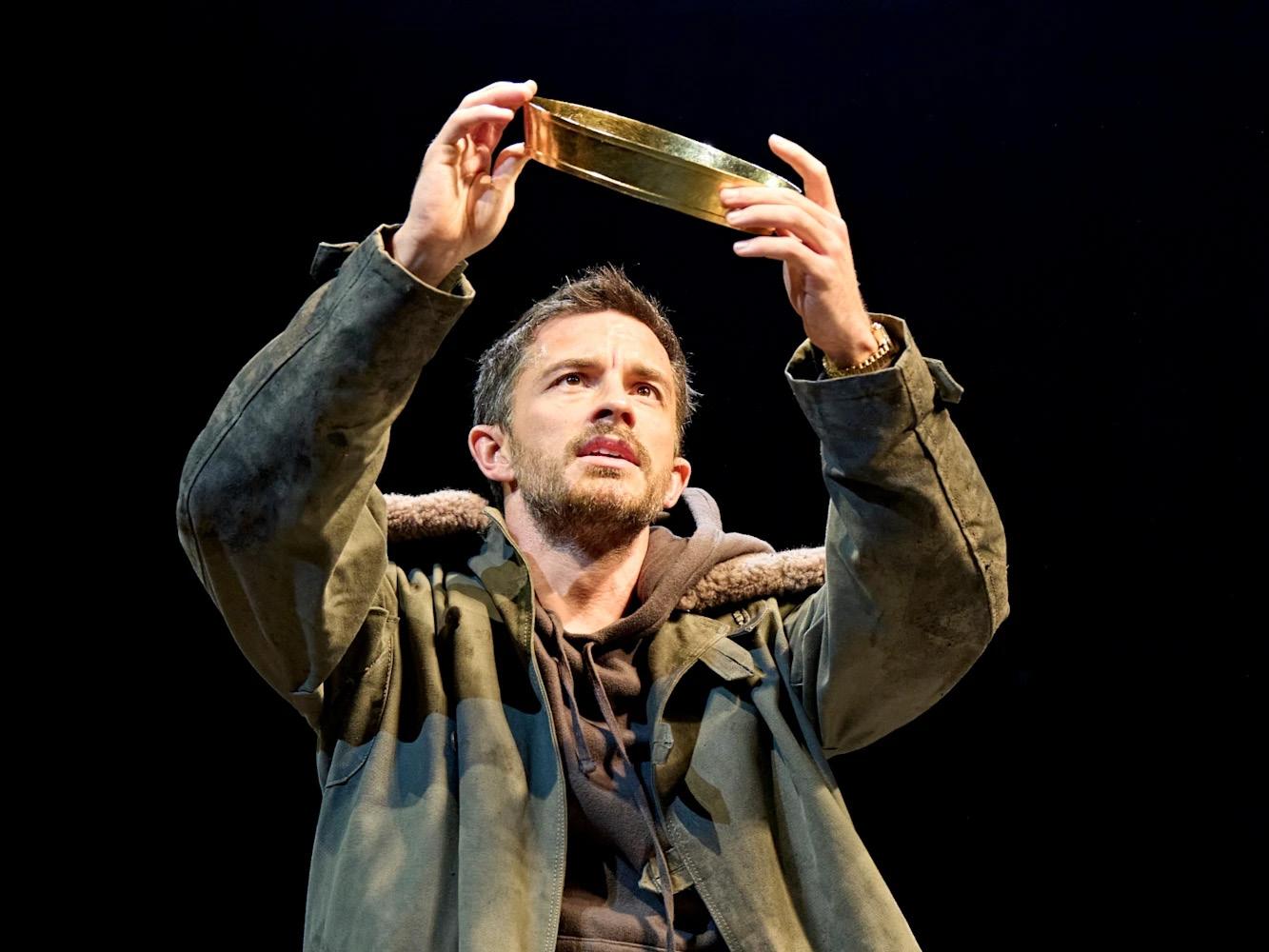
the personal and the political, bringing a combination of comedy, sexuality and darkness to live theater.
Rising star Daisy Edgar-Jones recently appeared in the West End’s “Cat on a Hot Tin Roof.” Edgar-Jones’ more recent roles in award-winning f lms “Where the Crawdads Sing,” and the “Twisters” sequel, where she appeared alongside Glen Powell, is likely where she attained her global recognition. However, true fans of the actress will recognize her as Marianne Sheridan from the on-screen adaptation of Sally Rooney’s “Normal People.”
After a long stint in the United States, Edgar-Jones returned home for Rebecca Frecknell’s revival of “Cat on a Hot Tin Roof” over the winter period. Having graced both Broadway and the West End multiple times, the play centers on a troubled Southern family struggling to cope with a crisis, their relationships riddled with lies and secrets. For “Normal People” fans, this wasn’t Edgar-Jones’ frst time grappling with a complex, dysfunctional family dynamic. However, her recent portrayal of a wife, rather than the teenage Marianne, showcased her maturity and evolution as an actress.
Another A-list actor to emerge from the world of Sally Rooney’s work is Paul Mescal. Taking on the infamously misunderstood Connell Waldron, Mescal can also trace his rise to fame back to the hit TV series “Normal People,” where he played Edgar-Jones’ love interest. Like Edgar-Jones, Mescal has since made his mark on the flm industry, starring in award-winning independent movies like “Aftersun” as well as the Hollywood blockbuster
The University of British Columbia professor provided new ways of thinking about interactions between creative Indigenous communities
BY SAVANNAH ANNO
arts@theaggie.org
On Feb. 18, the UC Davis Department of English hosted the newest installment of its annual University English Department Speaker Series, welcoming Professor Alice Te Punga Somerville from the University of British Columbia.
A professor of English and critical Indigenous studies, Te Punga Somerville examines literary histories and the intersection of Indigenous writers across the Pacifc. She is also a creative writer herself, with her 2023 poetry collection titled, “Always Italicize: How to Write While Colonized.” Before diving into her presentation, “‘Scatter: Shapes of Indigenous Pacific Literary Genealogy,” Te Punga Somerville opened with a land acknowledgment in Māori and followed with a recitation of her poem “Room.”
Tey think they are at the center of the room, but that’s only because they have never been anywhere but here,” Somerville said. “But there’s no room. No walls, no room — just links and connections and space. You’re not at the center, there are no centers.”
Framing much of her discussion around this concept of challenging Eurocentric assumptions and relying on the idea of connection to shape what she calls “literary genealogies,” Te Punga Somerville’s current work highlights relationships between Indigenous Pacifc writers that would otherwise go unobserved.
“National literary studies can be a bit parochial [narrowed] on a bad day, and even when transnational and beyond national networks are traced, they often focus on communities connected to that nation via migration or empire,” Te Punga Somerville said.
To combat this, and to honor each Pacifc country’s independent literary histories — defned in her work as New Zealand, Hawaii, Fiji and Australia — while also recognizing the important interactions they have had with one another, Te Punga Somerville utilizes scholar Renya K. Ramirez’s concept of “Native Hub,” or “Te Hub.”
“‘The Hub’ is proposed as a metaphor for dynamic Indigenous movement and connection between here and there, a homeplace in diaspora, to reject the common assumption that Indigenous people are immobile and can include many overlapping Indigenous realms,” Te Punga Somerville said. In her work, Te Punga Somerville identifes New Zealand, Hawaii, Fiji and Australia as four diferent hubs of Indigenous writers. However, she argues that while they can be thought of as entirely separate from one another, within her work she regards them as parts of a whole that exist together to form the shape of Indigenous Pacifc literature.
“I kept bumping into two things that didn’t feel connected until I engaged in the concept of ‘Te Hub,’” Te Punga Somerville said. “I’ve been unable to overlook that there’s an active presence of Indigenous Pacifc people from outside each local state, in each story of Indigenous literary production, in all four of these sights. Second, despite New Zealand, Fiji and Hawaii each claiming they’re the birthplace of Pacifc literature, what I’ve found is so much evidence that, due to historical and colonial era regional connections, all of these sights factor together as [multiple] networked hubs.”
Learn more about the customs that come with the extra day (just not this year)

BY DEVANSHI AGNIHOTRI arts@theaggie.org
“Gladiator II.”
Tennessee Williams’ play, “A Streetcar Named Desire,” recently returned to the West End for a brief three weeks at the Noël Coward Teatre in London, where Mescal reprised his turn as Stanley. Tis short run will be met by a slightly longer Broadway showing, as the production is set to move to New York later this year. This isn’t the first time Mescal has stepped into the world of live performance. Even prior to his breakout role in “Normal People,” Mescal had already made a name for himself in theater. Across the United Kingdom, he has performed in productions including Te Great Gatsby” and “Te Plough and the Stars,” while extending his hand to musicals such as “Te Phantom of the Opera” and “Les Misérables.”
Te trend of Hollywood A-listers moving to the stage continues to grow. After his recent performance in “Wicked,” it’s no surprise that Jonathan Bailey is now showcasing his theatrical talents to a live audience. Te “Bridgerton” heartthrob is currently the lead in West End production of “Richard II,” where he effortlessly channels his charisma and wit into the character of notable King of England from the 14th century.
Looking ahead, the intersection of flm and theater remains a popular one, with many more actors set to appear in West End and Broadway productions this summer and fall. So if you haven’t managed to see your favorite star perform in person just yet, you still have the chance to catch them in action.
Mark your calendars for Feb. 29
— a phrase that can only be said every four years. A leap year contains 366 days instead of 365 days, with the extra day being Feb. 29. A year must be divisible by four to be a leap year. But if the year is a century year, it must be divisible by 400 in order to be a leap year.
Te history of the leap year traces back to Julius Caesar, who is known as the “Father of Leap Year.” In 45 B.C.E., the Romans had to create a 22 or 23day month every second year in order to keep festivals occurring around the same season each year. As a solution, Caesar created the 365-day calendar, introducing the idea of a day being added to February every four years.
But what if you were born on Feb. 29? When a person’s birthday is on leap day, they have the privilege to faunt the title of being a “leapling,” as well as having the rarest birthday of the year. Although their actual birthday is celebrated every four years, they still have the option to celebrate their birthday on either Feb. 28 or Mar. 1. So, this year, make sure to show your friends missing a birthday a little extra love.
Some parts of the world do not hold an appreciation for leap years.
For example, in Italy, leap years are viewed as unlucky. “Anno bisesto, anno funesto” is an Italian proverb that translates to “Leap year, disastrous year.” Tis Italian consensus on leap year encourages you to avoid big purchases and events during the leap year. Greece is also letting out a sigh of relief as they hold a superstition that marriages during the leap year have bad
luck. Additionally, a divorce during a leap year could ultimately mean never fnding love again. All this to say, these superstitions are merely based on beliefs that have yet to be factually proven, so don’t stress that an extra day in the year heightens the probability of bad things coming your way. However, if you are in Ireland or Scotland, the next couple of years might be years of yearning. In these countries, a leap day is known as Bachelor’s Day or Ladies Privilege, a day when women propose to their lovers. Tis holiday goes all the way back to 1288 A.D. when women were granted the ability to propose after it was legal to do so. Some places might be preparing their celebrations for 2028, due to the excitement the leap year brings in its anticipation. In France, a satirical newspaper called La bougie du Sapeur is published every Feb. 29, making it the world’s only quadrennial newspaper. Anthony, Texas holds the title of “Leap Year Capital of the World” and shares the title with Anthony, New Mexico. Te town straddles both of the two states’ borders and hosts a leap year festival every leap year. Tis title originates from local leaplings approaching the Chamber of Commerce in 1988 with the idea of hosting a leap year birthday club and festival. Birthday celebrations and parades commemorate the day and celebrate the “leaplings” of the town. Te extra day that leap year provides warrants an extra celebration in the year to celebrate those around you and even some whose birthday parties will actually take their rightful place. Mark your calendars for 2028 to celebrate leaplings and the extra day in store.
For a sweet and inspiring movie night, try one of these films BY NATALIE SALTER arts@theaggie.org
Tere are few genres of flm as comforting as the coming-of-age story and the romantic comedy. Te former shows us that we will all have a chance to blossom and grow into new, braver and perhaps wiser individuals; Te latter instills hope that true love, with all of its dramatic declarations and heartfuttering frst kisses, is still alive and real.
Naturally, the intersection of these two realms of storytelling is bound to create a beloved new genre, in which fnding love and fnding yourself can happen within one another. Tere’s a lot that we can learn from these flms — not only will you fnd yourself laughing and blushing watching each of them, but you’ll also be inspired to chase your dreams and fearlessly pursue the things that make life invigorating.
“To All the Boys I’ve Loved Before” (2018) dir. Susan Johnson
Hopeless romantic Lara Jean Covey (Lana Condor) is perfectly happy to keep her wishful thinking safe inside her head, dreaming of true love while baking or cleaning her room rather than chasing a real (and thus terrifying) relationship. But when a series of private letters she wrote to previous crushes get sent out, there’s no chance of hiding now. To avoid trouble with the boy she’s been obsessed with for years — who also happens to be her older sister’s ex-boyfriend — she strikes up a deal with popular athlete and fellow letter-recipient Peter Kavinsky (Noah Centineo) to pretend to date in order to make their respective crushes jealous. Of course, neither of them is prepared for the feelings that bloom between them along the way.
Lara Jean’s experiences throw her into a journey flled with love and selfdiscovery, making “To All the Boys” a perfect example of a coming-of-age rom-com. While finding a swoonworthy romance that she thought was just a fantasy, Lara Jean also learns to be confdent and self-assured in pursuing what she wants. If you consider yourself a hopeless romantic, take Lara Jean’s story as a reminder to take that leap, even if it might be scary. Staying in your
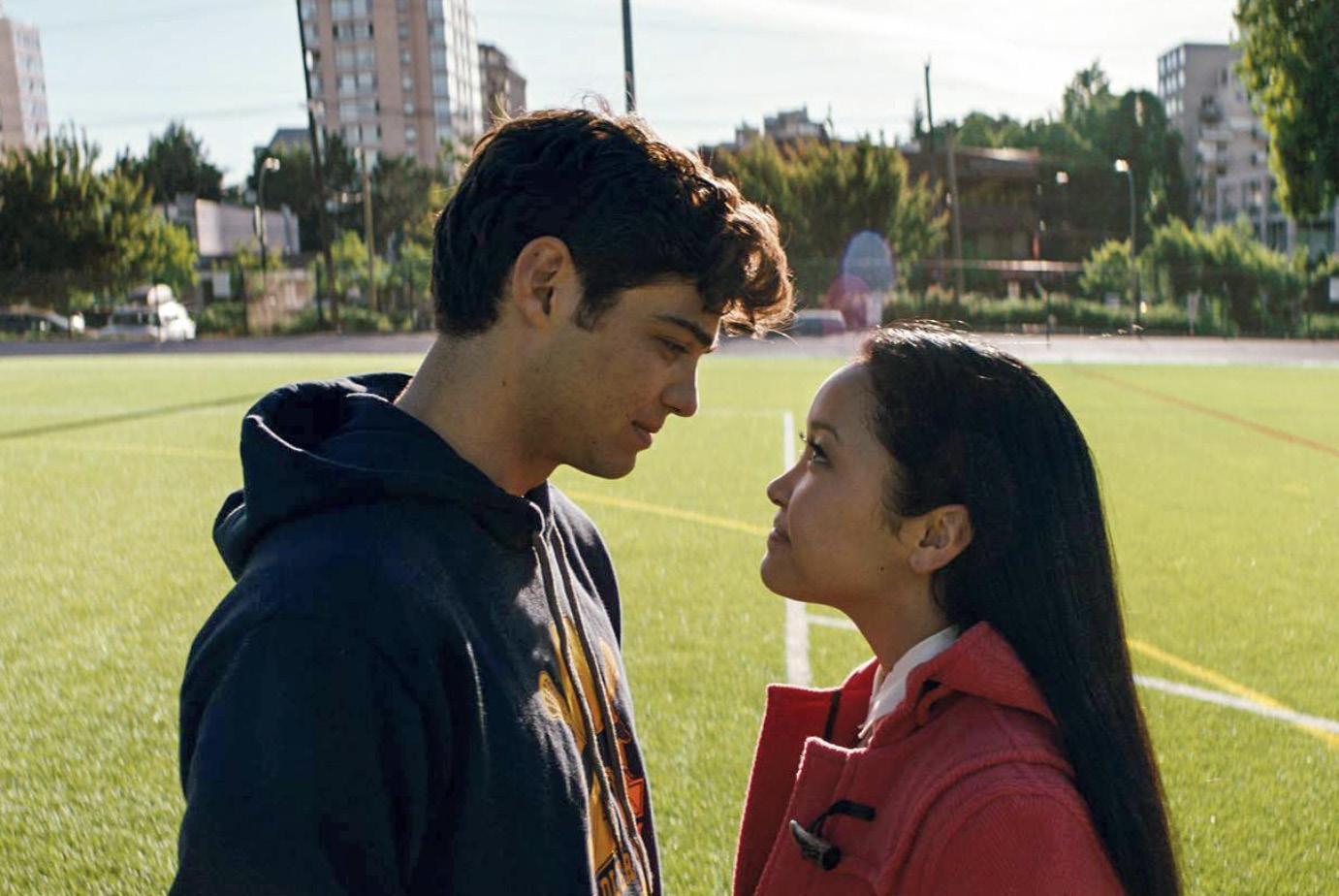
comfort zone is safe, but your dreams won’t come true until you’ve fully stepped out of it and taken a big risk.
“10 Tings I Hate About You” (1999) dir. Gil Junger
In a contemporary twist on Shakespeare’s “The Taming of the Shrew,” the beloved 1999 flm “10 Tings I Hate About You” begins with shy new student Cameron (Joseph Gordon-Levitt) falling in love at frst sight with the pretty and popular Bianca Stratford (Larisa Oleynik). However, he quickly faces two obstacles in his pursuit of Bianca. One is the fact that she can’t date until her older sister Kat (Julia Stiles) does, and the other is that Kat is a headstrong, proudly feminist rebel who has no interest in dating whatsoever. To win Bianca’s afection, Cameron makes it his mission to fnd a guy for Kat, convincing the vain Joey (Andrew Keegan) to pay the delinquent Patrick (Heath Ledger) to sweep her of her feet. Te two love stories — Bianca and Cameron and Kat and Patrick — intersect, as real feelings grow in unexpected ways.
Not only is “10 Tings I Hate About You” sure to bring a smile to your face, but it will also deliver an important message for anyone who relates to either of the two very diferent Stratford sisters. Kat learns to be vulnerable with her loved ones rather than shield her heart from everyone, and Bianca learns that real connection and joy are better than chasing what’s popular or conventional.
Either way, it’s a poignant reminder that sometimes, fnding happiness means defying the expectations others have set out for you and that it’s okay to be a little unconventional in the pursuit of a life worth living.
“Clueless” (1995) dir. Amy Heckerling
Another clever ‘90s adaptation of a classic work of literature is “Clueless,” deriving its plot from Jane Austen’s “Emma.” Pretty, popular and rich protagonist Cher Horowitz (Alicia Silverstone) has everything she could want — except a good grade in debate class, no thanks to her grumpy teacher. Hoping to negotiate her way into an A, Cher covertly sets him up with another faculty member and discovers she has a talent for matchmaking along the way. Of course, trouble still fnds its way into Cher’s glamorous life. She fnds herself mentoring the sweet outcast Tai (Brittany Murphy) in the ways of being popular, all while her frustrating stepbrother Josh (Paul Rudd) gives her fack for her vanity and naivety. Cher gets both the coming-of-age and rom-com treatment, falling unexpectedly in love while learning how to be more selfess and thoughtful in how she treats the people around her.
Tere’s lots to love about “Clueless,” its bright cast of characters and playful sense of humor being particular standouts, but there’s a lesson to be learned from it, too.
From peaceful paths to the vibrant streets, discover the best spots for a “hot girl walk” while prioritizing safety and confidence
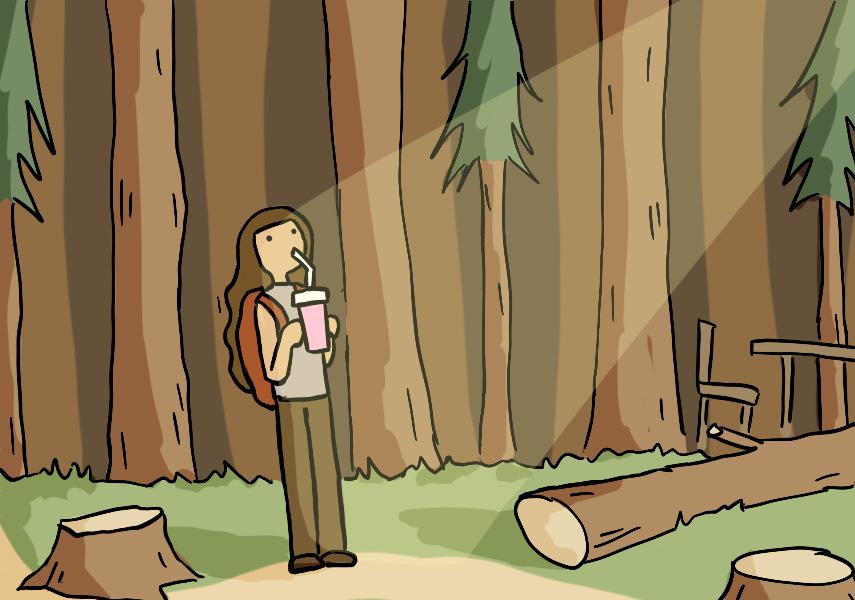
BY JALAN TEHRANIFAR features@theaggie.org
A few years ago, the simple act of going on a walk got a full rebrand, and thus, the “hot girl walk” was born. Coined by TikTok creator Mia Lind in 2021, the “hot girl walk” isn’t just about getting your steps in — it’s a state of mind. Since posting her frst walking video to the social media app in January 2021, the hashtag “hotgirlwalk” has cultivated more than 641 million views, according to CBS News.
Te rules are simple — walk for about four miles while focusing on three things: what you’re grateful for, your goals and, of course, how hot you are. What started as a ftness trend quickly evolved into a lifestyle movement, empowering people (of all genders, despite the name) to romanticize their daily strolls, clear their minds and embrace their inner confdence.
From city sidewalks to suburban trails, the “hot girl walk” has taken over, and in a town like Davis — where bike paths and scenic routes are abundant — there’s no shortage of places to strut your stuf. But where exactly should you go for the ultimate “hot girl walk” in Davis? For a scenic and serene place to walk, the UC Davis Arboretum and Public Garden is widely considered a Davis must. Stretching along the Putah Creek waterway, the Arboretum features 100 acres of trails, shaded paths and curated gardens. At the Arboretum, students can admire California’s native plants, stroll past the Redwood Grove or watch ducks foat by on the water.
Te Arboretum also has several bridges and resting areas, making it a great place to pause and take in the surroundings. Plus, the looped pathways
mean you can tailor walks to the exact distance you want or switch it up every now and then.
Eva Jabbari, a third-year environmental policy analysis and planning and international relations double major, likes to “hot girl walk” in areas with beautiful surroundings. Jabbari’s go-to location to leisurely walk around is the West Area Pond by the Aspen Neighborhood.
“I like to ‘hot girl walk’ in West Davis,” Jabbari said. “Tere is a pond in between some houses. Tere’s trails in between the suburbs there because all the houses there have gardens, so they have a trail for them, and there’s a public garden. [...] If you walk along the garden, it’s really nice. Tere’s also a vineyard and an Italian restaurant around there.”
Sophia King, a first-year clinical nutrition major, lives on campus, so when she goes on a “hot girl walk,” she prefers to stay close to her dormitory. King often walks on Russell Blvd, admiring the sky and the people she passes by. Te welllit streets, consistent foot trafc and lively atmosphere make it a comfortable option for a night walk.
“I really like walking around between Cuarto and Segundo,” King said. “It actually feels really safe. […]
All the Greek [life] houses are lining the road and there are a lot of cars driving, so there are people all around, even at night. I’ve never felt scared walking there alone. Even once you pass the frat houses. [And when] you’re in the Cuarto area and there are always people there too. I usually go from Cuarto to Segundo and then I lap around until I feel like going home.”
For students who prefer to see more people and less nature during their “hot
girl walk,” Downtown Davis ofers a lively environment with plenty of cofee shops, restaurants and boutique stores to admire. Te area is always buzzing with activity, so no matter the time of day or night, there’s always foot trafc, making it a great option for those who feel more comfortable walking in wellpopulated areas.
For those who don’t want to go outside — like Hana Raie, a thirdyear political science major — the Activities and Recreation Center (ARC) on campus is always an option. Te second foor of the ARC is covered with treadmills that allow you to adjust your walking speed and incline. “I just do my ‘hot girl walk’ on the treadmills at the ARC,” Raie said. “It’s cold outside.”
As “hot girl walk” creator Mia Lind said, you can’t be hot if you’re not safe. Staying safe while going on a walk is a priority, and while Davis is generally considered a safe and walkable town, it is always important to take precautions, especially when walking alone.
Te UC Davis Police Department suggests selecting safe routes that are well-lit and populated — avoid remote or secluded areas, especially at night. Whenever possible, walk with a friend or in a group to enhance safety. If you need to travel alone at night, take advantage of Safe Rides, a free service from the UC Davis Police Department that provides transportation from campus locations. Additionally, familiarize yourself with the locations of emergency call boxes throughout campus, so you know where to go if you ever feel unsafe or need immediate assistance. Stay safe, be present and enjoy the walk.
As homemade skate spots across Davis are taken down, patrons grapple with how to rebuild

BY EMME DUNNING features@theaggie.org
In the past year, multiple patronmade skate spots have been taken down across diferent jurisdictions including UC Davis land, city of Davis land and across rural Yolo County. Te do-it-yourself (DIY) skate spots have been built and maintained by their patrons, who are now coping with the loss of a beloved community gathering place.
Ben Salko, a third-year landscape architecture major, has been skating since elementary school. Salko asserted the importance of skating in his daily life and the role it plays in building positive connections in the community.
“It’s been a source of community and friendship since then, as well as being a great way to push myself physically and express myself,” Salko said.
Since coming to Davis, Salko expressed disappointment in the park options that the city of Davis ofers for skating.
“The Davis skatepark fails to meet the needs of the majority of skateboarders and is very run down,” Salko said. “It has been ranked as one of the worst skateparks in the [United States] a couple of times.”
Salko and his friends recognized the importance of an adequate skate park in cultivating a thriving community and set out to create a halfpipe ramp in an open feld tucked behind Te Domes. Te halfpipe was made primarily out of wood and could comfortably support multiple people. At one point, couches were even brought to the spot, providing a multi-functional place for people to skate and socialize.
“Word of this place quickly spread,” Salko said. “Every time I went, I would meet new skaters from the area excited for the opportunity to skate a fun ramp in Davis. We quickly had a third space — a true home away from home — where everyone could hang out and push each other to learn and improve.”
Despite the growing popularity of the ramp, it was taken down last August by an unknown party, causing a rift within the skateboarding community.
Other DIY parks, including the Davis Ditch, a converted concrete bowl in a feld of of County Road 32A, have faced similar instances of demolition.
Te Davis Ditch featured curbs, quarter pipes and boxes made primarily from reused and found materials that came together to make a functional skatepark. It was a longtime local hub for recreation and creativity, something that UC Davis students and locals have come to appreciate.
Colin Carter, a Davis local and avid biker, enjoyed the collaborative nature of the DIY spots.
“Te people you’d meet at a DIY spot were all super into constantly improving and maintaining it,” Carter said. “You knew every time you would show up, there may be a new feature or some work to be done, which was part of the fun.”
Tis unique feature has made the recent demolition even harder for those who frequent the spots.
“Coming back and seeing them slowly being taken apart over the last few months has defnitely been sad to say the least,” Carter said. “I’ve been able to get out and see them again, which may be the last time.”
Trey Brown, a third-year global disease biology major, was introduced to the DIY spots through a friend and was immediately drawn to their innovative models.
“You knew that people had put time and efort into making the park,” Brown said. “It was diferent, but encouraged you to get creative to make the space work.”
Brown asserted that the DIY spots were not a safety or waste concern and that patrons were committed to their maintenance.
“Tey caused no harm and weren’t in the way of anyone,” Brown said. Tey remained clean and were purely a place for people to gather and enjoy themselves.”
Students discuss the resources libraries offer and how to show support BY AMBER WARNKE
features@theaggie.org
As February comes to a close, many students have recognized National Library Lovers’ Month, a time to express specifc appreciation for the libraries that ofer countless resources to community members. In Davis, this includes the public Mary L. Stephens Library and the Peter J. Shields Library on campus, which is well known to busy college students studying for fnals, borrowing textbooks, printing essays and more.
While it is commonly understood that libraries loan books, they are also important hubs of community building and cultural diversity. Local libraries have held events such as the Year of the Snake celebration at the Mary L. Stephens Library on Jan. 18. Te Shields Library also hosts community events, such as an “Art at Shields” percussion event that was held on Feb. 25 and a “Data Science Tea Time” event on Feb. 27 and March 6. Tea Wagner, a ffth-year sustainable agriculture and food systems major, touched on the important role she believes libraries hold.
“I think they’re wonderful community spaces, and they’re incredibly vital public spaces,” Wagner said. “Public spaces, libraries in particular, provide a really important resource to the community in that it is free and accessible to everyone. Tey often have free bathrooms, free water, it’s usually accessible [and] a lot of them have free Wi-Fi. Also, sometimes you can get free or limited computer access.”
In addition to its ample resources, Shields Library also received 52% of votes for Best Study Spot in the 2024 Best of Davis survey.
Public study spaces like libraries are becoming increasingly important as more and more spaces are being monetized. Other public spaces such
as malls are based around selling merchandise, and many cofee shops expect patrons to purchase something in order to use that space for studying or socializing.
In this way, libraries are able to act as third spaces — a place outside of the home and work for community building and social interaction — while standing as symbols of free educational resources for all.
Quinn Chapin, a third-year English and history double major, works at the Shields Library circulation desk, welcome desk and discharge area, where books are checked in. Chapin believes that libraries provide opportunities to both community members and, specifcally, to students.
Tey’re a really good resource for people in the community because it [ofers] equal access to information,” Chapin said. “And specifcally as a student, I fnd that I get a lot of books here from the library.” Despite their many resources, libraries have been losing funding for years, with New York City’s mayor proposing to reduce the city’s library budgets by more than $58 million in 2024. Te National Archives and Records Administration has also reported having to get by on its slimmest budget in 30 years in 2024. Tis issue is only likely to get worse, with libraries often being seen as sucking up public funds due to the fact that they do not churn a proft.
Chapin commented on the benefts libraries can provide and why it is important that they receive proper funding.
Tey could defnitely be funded a little bit more, because they’re a really important resource for people who don’t necessarily have the personal funds to purchase books because of how expensive books are,” Chapin said.
Rebecca Newman, a fourth-year English and cinema and digital media double major, works at the Shields

Library. Newman believes that libraries are increasingly important even as more and more people are relying on digital mediums for information.
“Don’t forget about libraries — because in an advancing digital age where everything is online and there’s a rise of technology like [Artifcial Intelligence], misinformation is getting more and more rampant,” Newman said.
“Libraries are going to be more important than ever. Not just in terms of staying informed, but libraries as a space are an incredibly valuable resource that a lot of people won’t recognize they need until [they’re] gone, because a lot
of libraries are losing funding and losing support.”
Tere are many things that students can do to show support for their local libraries, both on and o f campus. Newman suggested that students frst support their libraries simply by using the resources they provide.
“Just being in this space and using the resources helps keep them afoat, because showing that members of the community use the resource is often just enough to keep it going,” Newman said. Wagner also ofered her view on how community members can show support for their local libraries.
“Just signing up for a library card keeps things afoat there,” Wagner said. Students looking to get even more involved can reach out to their local public libraries about volunteer opportunities, such as the Mary L. Stephens Library, which offers opportunities for tutoring adult learners and language tutoring for Spanish or English as a second language. No matter how students choose to support their libraries, the most important thing they can do to keep them alive, as these UC Davis students have shared, is by continually showing up.
Enter digits from 1 to 9 into the blank spaces. Every row, column and 3x3 square must contain each digit. Each Sudoku has a unique solution that can be reached logically without guessing.
Answer to previous puzzle 02/20/25

advocate.
Waqar advocates for the international student community through working on legislation and events that represent them in the ASUCD Senate. Some events the Ofce of the ISR has worked on include the ASUCD Supporting Students event following the inauguration, celebrating Kashmir Day and an informational session about Shi’a Persecution. Waqar said he aims to create spaces of dialogue and visibility at these events.
In a White House fact sheet announcing the Trump administration’s “forceful and unprecedented steps to combat anti-semitism,” Trump pledged to “Deport Hamas Sympathizers and Revoke Student Visas.” Te executive order references current immigration laws which allow for the deportation of a noncitizen who “endorses or espouses terrorist activity or persuades others to endorse or espouse terrorist activity or support a terrorist organization.”
Groups like the Council on American Islamic Relations (CAIR) claim the executive order attacks free speech and censors solidarity for Palestine “under the guise of combating antisemitism,” citing an article from Te Guardian that found that 97% of demonstrations were peaceful and involved both Jewish and Palestinian student groups.
A pro-Palestine student advocate, who wishes to stay anonymous out of concern for safety, pointed out that during UC Davis’ Palestine encampment, disclaimers were given to international students participating about potential consequences relating to immigration and visa status. Tey recommended that international students conceal their identity if they choose to continue to protest and
Tere’s still always ways to show support, even if it’s not very outward and direct, which a lot of international students here have found a way to do so,” the advocate said. “I’m very grateful that they still care enough to show up when a lot of other people don’t.”
Trough the news cycles about executive orders and policies, Shiotani advised students to rely on communications from SISS as they work with partners at UC Davis and the UC system, in addition to professional and legal organizations.
“It is important for community members to support one another and stay informed,” Shiotani said. “SISS remains committed to providing resources and assistance to international students and scholars as new policies emerge.”
FROM PAGE 2
Gloria Partida, the executive director of the Davis Phoenix Coalition, explained the group’s involvement in the event.
“As part of our mission to raise the visibility of marginalized communities, we felt that participating in this event fts well with our mission,” Partida said.
“In today’s environment, where we see once again the rise in villainization of immigrant communities, it is important to remember our history and the injuries of the past so that we don’t make these mistakes again.”
Partida further elaborated on the Davis Phoenix Coalition’s role in addressing historical injustices.
“Our mission is to gather and engage the community to eliminate intolerance and prevent hate-motivated violence,” Partida said. “One of the ways to do this is by creating safe spaces to explore difcult topics that further
our understanding of each other.”
Carole Hom, a spokesperson from the Episcopal Church of St. Martin, explained the church’s role as a cosponsor.
“The Episcopal Church of St. Martin has long been engaged in ministries centered on justice, international and domestic poverty relief, reconciliation and creation care,” Hom said. “We take to heart the Biblical exhortation to be merciful, to care for the least among us, to welcome the stranger.”
Hom commented on the event’s historical signifcance and themes that are still relevant today.
“In 1942, virtually no one spoke out to oppose the imprisonment of Americans of Japanese descent,” Hom said.
“In 2017, members of the Japanese American community were among the frst people to protest the Muslim and refugee ban. In 2025, we have already seen the detention of undocumented persons in Guantanamo Bay and the deportation of others within days of their scheduled asylum hearings. It’s important that we all stand together in such times to support those who have been targeted.”
Fong similarly urged community members to take action and deepen civic engagement in their daily lives.
“We should not be complacent just because we personally don’t have a target on our backs,” Fong said. “We want more people to feel empowered to make a diference.”
Hom echoed a similar sentiment for attendees to walk away with a renewed sense of purpose and responsibility, understanding that collective action is key to driving meaningful change.
“We hope that attendees took away a better understanding of the history of the World War II Japanese concentration camps and the lasting diference that individuals can make,” Hom said.
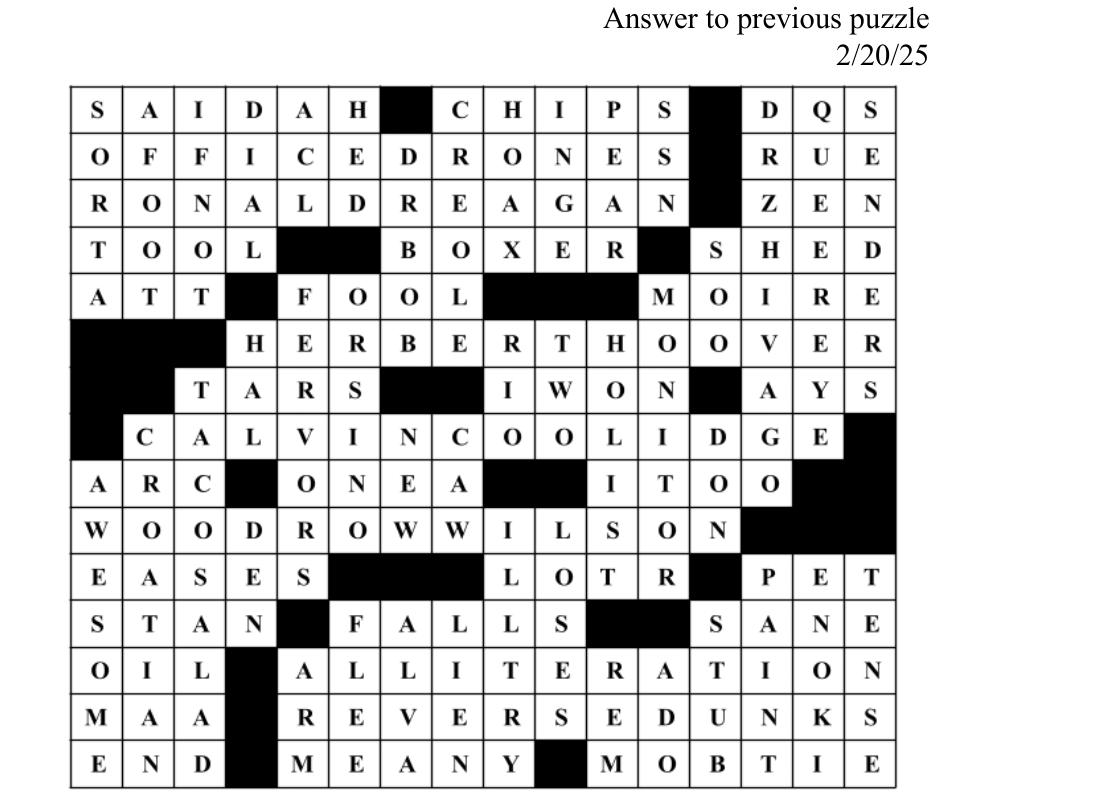
“I [want to] share it with people that have heard me ranting about midterms and the worst [times], and it’d suck to be with these people for four years and get separated just because the site crashes.”
Fortunately, Chrisman was able to get the Saturday 9 a.m. time slot. Te website did crash as soon as the commencement registration link went live on Feb. 25 at 10 a.m. As soon as the website was refreshed, a blank webpage with the words “Service Unavailable” continued popping up on students’ screens.
By 10:15 a.m., the Saturday ceremony reached full capacity.
Two years ago, one Reddit user on the subreddit r/UCDavis also noticed some discrepancies within the website, asking how the Saturday at 2 p.m. commencement time slot met capacity just minutes after the registration portal opened. Teir screenshot showed that the 2 p.m. slot was unable to be selected due to full capacity. Other users noticed that the link went live well before 9 a.m. and didn’t alert students, adding to the confusion.
“The site is going to crash,” Chrisman said. “Defnitely.” Guzman instead expressed ambivalence to the idea of a website malfunction.
“If I don’t get Saturday, then I’ll try to get Sunday, and if I don’t get Sunday then I’ll try to get Friday,” Guzman said. “I’m just hoping to get a day.” Guzman was able to fnd a spot for the Sunday at 9 a.m. though it wasn’t her ideal choice.
“A little irritating, but I’m graduating, so whatever,” Guzman said.
Despite not registering for the chaotic spring commencement times, Li still recalls what her friends, who were graduating in spring, experienced.
“I remember being at my internship back when it was happening in spring and people were refreshing the page and the website wouldn’t work,” Li said. “Glad it wasn’t me — stay safe out there. I am fortunate to not have faced that hardship.”
Commenting from first-hand experience, Haidinger commented on the annual crash.
“Since everyone is interfacing with the website at the same time, no matter what day you want, [the website] just couldn’t handle it,” Haidinger said. “So, after repeated crashing at various stages, I fnally got it.”
Guzman expressed that she is primarily concerned with the outcome, rather than the time.
“I’m not too nervous about the website potentially crashing,” Guzman said. “If it crashes, there isn’t anything I can do about it. I just know that I’ll end up registering for something.”
The actual commencement ceremony has also seen its struggles.
Traditionally held at the UC Davis Health Stadium, spring 2022 saw record heat waves since the reimplementation of in-person ceremonies following COVID-19. Te June 10 ceremony was continually pushed later into the day,
resulting in overheating on the plastic turf within the enclosed stadium.
Te Los Angeles Times reported that there was a lack of water, shade and organization that led to the eventual 36 heat-related medical calls. Makeup ceremonies had to be organized last minute and many students were unable to attend the listed dates.
Since then, commencement ceremonies have been held at the airconditioned, shaded Golden 1 Center in Sacramento.
Commencement registration has sparked frustration and confusion among UC Davis students. While some emerged from spamming the refresh button with victory, other students across campus couldn’t say the same. Regardless of commencement time slots and dates, UC Davis students look forward to the ceremony and celebration of their years of hard work and dedication to their academic careers.
Within the article, it outlined how the eggheads contracted the bird fu and how their antibodies were unlike any other. Apparently, the eggheads held the cure, because the eggheads aren’t chickens, but they are eggs themselves.
From the article, it seemed as though my professor cured the avian fu for chickens and solved the supply shortage of eggs. Sadly, the career fame got to his head, because in the image, he was wearing a large gold chain around his neck, a gold watch and Gucci sunglasses. He even had a goldplated egg. My professor is the golden goose of the eggheads.
Once we fnish rejoicing over the anticipated lower price of eggs, I think we should shift our focus to the real question: Since when did the eggheads become alive?
Disclaimer: (Tis article is humor and/or satire, and its content is purely fctional. Te story and the names of “sources” are fctionalized.)
4 Tat is, doing good things for others for their sake rather than for yours is one of the best things you can do for the world. Kindness and thoughtfulness will not only make the people around you happier but will bring light to your own life as well. And who knows — maybe, just like Cher, you’ll tumble into a wonderful love story of your own as a result.

The event, hosted by A Change of Pace, is an annual opportunity for active community involvement
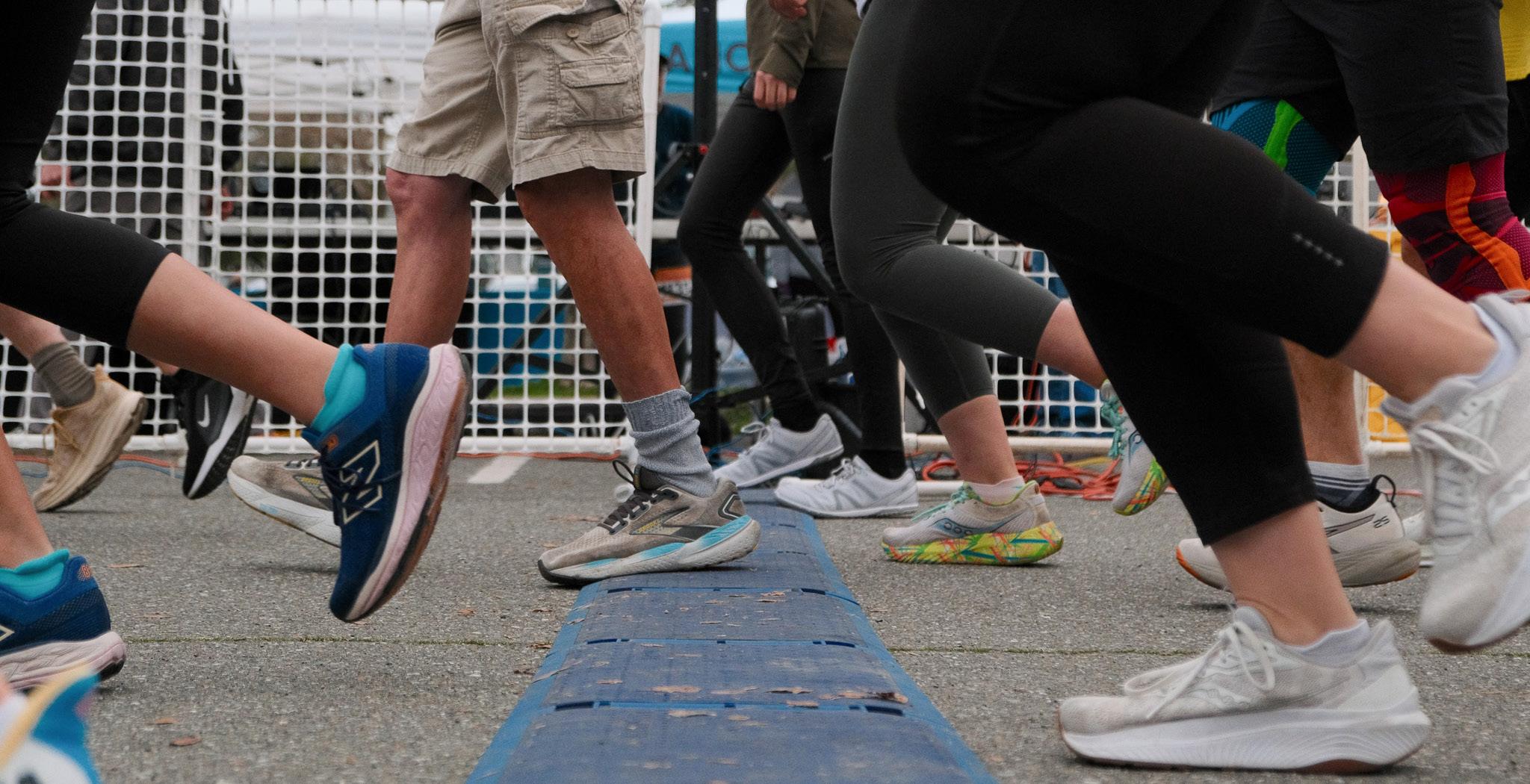
BY RACHEL GAUER features@theaggie.org
On Feb. 23, community members and students alike laced up their sneakers and hit the streets of Davis for the annual Davis Stampede race, which ofers a 2k, 5k, 10k and a half marathon for those looking to run in the community. Hosted by local Davis organization A Change of Pace, the event began in 1983 and strives to bring community members and students together for the shared goal of running and promoting healthy lifestyle practices.
All routes began at Playfelds Park in South Davis and brought runners through local neighborhoods, sections of the Greenbelt and, for half-marathon runners, up north along Wildhorse Golf Club.
Maya Miramontes, a volunteer for A Change of Pace and site coordinator, commented on the advantages of exploring the city through the event.
“You get to run all around Davis and maybe appreciate some of the parts of the Greenbelt you don’t normally see or the neighborhoods you never seem to cross through,” Miramontes said. “It gives even the most local people the opportunity to appreciate some of the areas that they may not be completely familiar with.”
Miramontes, a local resident herself, is the daughter of A Change of Pace founders, Dave and Jen Miramontes, who established the company in 1987 and acquired the Davis Stampede event just years later.
The organization hosts and coordinates additional races in town and in the greater Sacramento region, including the annual Davis Turkey Trot in November and Te Lucky Run in March.
Miramontes explained the organization’s goal for the events, which she summarized as striving to support health and wellness in the community.
“We put these events on to promote healthy and active lives,” Miramontes said. “We want to let people have these events to have a fun activity they can do that gets them outside and gets them moving while being able to bring [their] friends and family.”
Miramontes also described her personal history with the organization, which began through her family’s ownership and evolved to a more active role in its operations.
“All throughout middle school and high school, I was always volunteering and helping at these events, but it wasn’t about four years ago that I started to take on a bigger role in the company,” Miramontes said. “I’ve grown up with this team, and I love working with them. It’s been my whole life; I have always known this company.”
Sam Wu, a fourth-year physics major, and Sam Costello, a third-year aerospace science and engineering and mechanical engineering double major, frst registered for the Davis Stampede two years ago, both racing the 5k event. Now, the two have made a tradition out of the event: Wu explained that he and Costello, who are both part of the Cross Country, Track, and Field Club at UC Davis, have participated in the event together every year since.
“We did the 5k my first year, 10k last year and now doing the half marathon this year,” Wu said. “We make a thing out of it every year.”
Costello was injured prior to the race this year and was unable to run with Wu as planned. However, he commented on the experience of participating in the two prior events, highlighting the community-building element of the race.
“It’s as much an opportunity to race as it is for people to come together,” Costello said. “Sharing a common interest and a common goal is awesome. Any sort of activity that people do recreationally, if you can manage to make it an ofcial event within the community, I think [is] a great way to
The director, cast and crew share their experiences creating the play
BY GRACIELA TIU features@theaggie.org
On Tursday, Feb. 27 at 7 p.m., the UC Davis Department of Teatre and Dance’s production of the play “Small Mouth Sounds” will have its opening night. Te show, taking place at the Wyatt Pavilion Teatre, will have additional performances on Feb. 28, March 1 and March 6 through March 8. Student cast and crew have been working tirelessly since the beginning of the quarter to put together the production, which features elements of experimental and minimalist theatre. Jane Lee, a fourth-year theatre and dance major who plays the role of Alicia, described the preliminary audition process.
Te auditions held by the Teater and Dance Department are open to students of any major and year,” Lee said. “I signed up for a slot two days before the audition and prepared a monologue from a contemporary play. I printed out my resume, performed my monologue and had a conversation with the Director, Peter J. Kuo, and the Assistant Director, Ainsley O’Brien.”
Tis production followed a typical play audition process, calling back certain auditioners after their first auditions and asking them to read
through various additional pieces.
Once the cast was selected and rehearsals began in early January, the actors noticed how they came to build friendships and connections through their work.
“Every day, we grow closer as a cast,”
Lee said. “Since there are only seven of us — a small cast for ‘Small Mouth Sounds’ — every rehearsal has its share of exciting and fun moments. We share laughter, tears and valuable lessons from one another.”
Peter J. Kuo holds the position of the Granada Artist-in-Residence at the UC Davis Department of Teatre and Dance for winter 2025. “Small Mouth Sounds” cast members especially appreciate Kuo’s approach to directing and his enthusiasm in regard to character exploration.

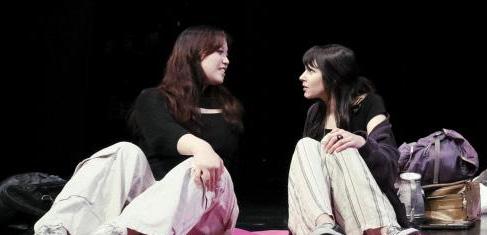
Following Trump’s executive order, Services for International Students and Scholars (SISS) and ASUCD’s Office of International Student Representative provide legal and advocacy resources
BY KHADEEJAH KHAN campus@theaggie.org
bring people together.”
Wu discussed the popularity of the event within the community, highlighting the vivacious nature of a highly populated race.
“It’s always surprising to me how many people show up and do it — there are hundreds of people in each race,” Wu said. “Sometimes there is a little issue trying to get around people and it can be a little crazy, but I think that’s what makes this race so much fun. Tere are so many other people doing it.”
Costello compared the event to others he has been involved in and highlighted the appeal of the relaxed nature fostered through the communitybased event.
“I’ve done competitive racing in high school through cross country and track and even in the club here,”
Costello said. “Sometimes you can feel that people are nervous and there’s a weird vibe — with community races like this, it’s a lot more relaxed and everyone seems to be there to have fun.”
Miramontes commented on promoting local businesses through the event, highlighting several sponsors of the event that she feels promote active lifestyles within the Davis community. Some of the sponsors include Orangetheory Fitness, which will be opening a location in Downtown Davis this year, and Milestones Movement Terapy, which is partnering with a new wellness spa center to open in town, Tulē
“We want to help support these new and expanding businesses coming into our community and give them a little jumpstart to reach the community [at] these events,” Miramontes said.
A Change of Pace’s next event is Te Lucky Run, which will take place on March 29 and ofers a 5k, 7k, 10k and a “Fun Run” for children. Te high volume of participants at Sunday’s race served as an indicator that the Davis population strives to foster a community that emphasizes active recreation and local togetherness.
On Jan. 29, President Donald Trump signed an executive order to endanger student visas of international students who participated in proPalestine protests. As international students and pro-Palestine organizers navigate the implications of this executive order, various centers on campus aim to provide resources for international students during this moment. Rights to free speech and protest under the First Amendment protect everyone in the United States, including international students and scholars. However, arrests or detainment can trigger immigration consequences for this community. In addition to physical forms of speech, digital engagement can also impact international students’ immigration statuses as U.S. Customs and Border Protection have the authority to review electronic devices when individuals enter the country, according to their website.
For some international students, the news of a second Trump presidency was a “point of fear,” as described by ASUCD’s International Student Representative, Muhammad Waqar, a fourth-year political science major and international student from Pakistan. He mentioned how some students expressed concerns and worries about how policies would impact their student visas.
“It really hits hard to international students, because as much as some of us want to take part in this, we also have the biggest fall or downfall when we go out and take these political stances,” Waqar said. “Our F-1 visa comes under scrutiny.”
One resource at UC Davis is Services for International Students and Scholars (SISS). SISS, within Global Afairs. SISS assists incoming and current international students and scholars with visa and immigration issues through preparing visa application documents, maintaining their legal status while in the U.S. and providing general support during their time at UC Davis. SISS provides these services to students and scholars who are on F-1, J-1, H-1B, O-1, B-1, E-3 and TN-type visas, according to their website.
SISS Director Andrew Shiotani noted that the international student community is large and diverse, and
there are students with various types of visas. SISS is one of many services provided for this international student community.
In the months before Trump’s inauguration, SISS held a town hall-style meeting for UC Davis international students and scholars on Dec. 6, 2024 and issued a winter travel advisory, recommending students and scholars to return prior to inauguration on Jan. 20. Following the executive order, Shiotani recommended students to reach out to their SISS advisors for guidance and rely on the SISS website for updated communications due to the unpredictable nature of recent developments.
“With regard to what the current administration has said about international students who participated in protests, it is difcult to predict the executive order’s impact on UC Davis international students at this time,” Shiotani said. “SISS will continue to monitor developments and provide guidance as needed.”
In regards to immigration matters, Shiotani adds that policies will impact groups diferently, including international students and scholars, undocumented individuals, permanent residents, asylees and refugees, which is why he recommends seeking personalized advice from appropriate sources. SISS also works closely with University of California Immigrant Legal Services Center (UCIMM), which provides services to undocumented and immigrant students.
In addition to immigration and legal services, ASUCD’s Ofce of the International Student Representative (ISR) provides advocacy, social and mental health resources for the international student community at UC Davis. Te ISR Ofce acts as a liaison between international students and the centers that represent them, including SISS, according to Waqar.
“In my office, we are taking certain actions in which we make sure that international students are heard,” Waqar said. “Tere are certain movements which you have to stand up for regardless, because they’re too close to your faith and they’re too close to your community, and that is completely understandable. One should do that because that is where your identity stems from.”
Is it a bird? Is it a squirrel? A turkey? Nope: It’s just a student in a tree again
Students at UC Davis discuss the nostalgia, mindfulness and excitement of climbing trees
BY JENEVAH HARRISON features@theaggie.org
If you have ever spent time near the East Quad on the UC Davis campus, chances are you have seen a humanlike fgure looking down at you from high up in the trees. Between studying for exams and writing essays, many students at UC Davis have taken to scaling the campus’ most inviting trees, channeling their inner Tarzans.
For some, tree climbing is just a fun way to pass the time; For others, it serves a more signifcant purpose. With the pressure of college life, it can be difcult to fnd moments of peace. Sometimes taking a quick break in between classes to climb a tree is all that is needed to heal us, with studies showing that tree climbing can be an extremely restorative and therapeutic pastime. Students can fnd this activity to be the perfect reset, discovering a sense of peace and joy within the swinging branches of a pretty tree.
“Sometimes, I will climb up one of the trees in the Quad here on campus and just sit up there for a while,” Angel Torres, a fourth-year sustainable environmental design major, said. “I’ve also done homework a couple times up there — it’s kind of just a way for me to reconnect with nature and fulfll a sort of youthful urge.”
Sometimes, fnding time to rest and regroup can be hard, but students like Torres are fnding fulfllment in the little things. Torres embraces this simple activity, and utilizes it not only as a nostalgic pastime, but also as an innate form of mindfulness. Sitting high up in the branches away from the campus crowds can allow students to unlock a sense of calm that is missing from their daily routines.
Climbing trees is often associated with childhood indiscretions, and just like most of these activities, tree
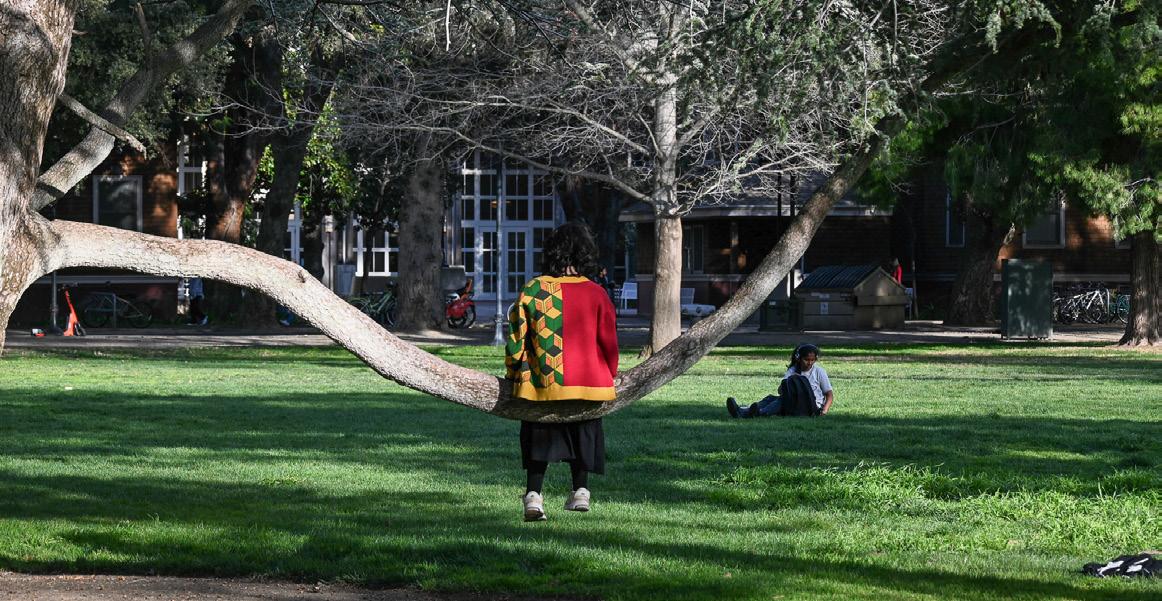
climbing gets left behind as a forgotten pastime. However, many students on campus are rediscovering this simple pleasure and fulflling a lost sense of excitement.
“It’s both comforting and exhilarating at the same time,” Torres said.
Torres also described the comfort of both re-living childhood experiences and testing the limits of your physicality — an often humbly rewarding experience. For Siena Safari, a frst-year history major, her motivation to climb trees presents itself as a more rebellious pastime and personal challenge.
“I like to climb trees, because it is something I feel accomplished doing — it takes a lot of upper body strength, and the feeling of relief when you climb a tree is indescribable, to be honest,” Safari said. “It’s also not a necessarily safe thing to do so it’s nice to be a little rebellious, you could say.”
While some may see tree climbing as reckless or childish, these students fnd that it’s the perfect blend of physical activity and relaxation. Scaling a tree requires both excellent physicality and a bit of courage, but once you reach a respectable level, the reward is a quiet place to sit, think or even study, as Torres does.
One of the appeals of tree climbing is the literal change in perspective.
The higher vantage point offers a unique view of campus, o f ering a transformation of a familiar landscape into something entirely new.
Tere’s something really nice about seeing everything from a diferent angle but also being outside of it,” Patrick Kemp, a third-year anthropology major, said. “It’s kind of like an escape from everything on the ground, including whatever stress you’re experiencing.”
For some, climbing is also a way to feel connected to a larger environmental presence. As UC Davis students, many of whom are passionate about sustainability and the environment, spending time in the trees enhances this connection on a more personal level.
“I defnitely feel more connected to nature when I’m up in a tree, for obvious reasons, like you are literally sitting on a giant organism that grew from the earth,” Kemp said. “It sounds cliche, but it’s a super peaceful experience.”
Students are embracing these moments of adventure, youthful fulfllment and the simple relief of a quiet atmosphere, proving that climbing trees is a wonderful tool of escapism, even amidst adulthood and the tumult of college life.
“Or maybe,” Torres said. “It’s just a result of the primal urge from our monkey ancestors.”
UC
Davis researchers demonstrate a new etching method
The new research may pave the way toward mass production of quantum devices

BY EKATERINA MEDVEDEVA science@theaggie.org
It is quite hard to break down something fundamental with a single atom, let alone with a subatomic particle. However, classical mechanics is an exception.
On very small scales, it is the laws of quantum mechanics that dictate properties and behavior of particles.
Unique features that they outline, such as state of superposition and quantum entanglement, give rise to many applications, including the feld of quantum information processing (QIP). Te technologies that implement QIP can enable humanity to solve problems unconquerable for modern computing tools.
Te devices of interest for these tasks are nanophotonic devices, which are able to manipulate light — more precisely, photons — at nanoscales. However, fabrication of this type of hardware that can harness quantum phenomena and eventually integrate the QIP protocols is extremely challenging, and on top of that, it needs to be afordable and scalable.
UC Davis research group, led by Associate Professor of Electrical and Computer Engineering Marina Radulaski, addressed this complex of problems by proposing in their study a new method of etching the nanostructures at an angle in silicon carbide (SiC) on wafer-scale substrates.
Tese are thin slices of SiC that can be implemented into a device.
“It is new to our feld for silicon carbide quantum photonics, because
Tis constant collaboration between each local region of Indigenous peoples is one of Te Punga Somerville’s main focuses when examining Indigenous Pacifc literary genealogy, observing what she calls “lateral Indigenous connections.”
Tese lateral connections challenge the idea that the writing of Indigenous communities is only understandable in relation to the contemporary confguration of contemporary colonial states or that they can be represented by a narrow line-up of widely known authors,” Te Punga Somerville said. While researching for her current book project, “Belonging Together: Periodicals and the Indigenous Pacifc,” Te Punga Somerville also came across the word and idea of “scatter,” which spurred the topic of her guest lecture.
Mentioned in the writings of two signifcant Indigenous Pacifc scholars, Steven Winduo and Albert Wendt, Te Punga Somerville explained that “scatter” can be used to describe both the expansiveness and the fragmentation that exists in Indigenous Pacifc literary history. While Winduo’s mention of “scattered” speaks to the lack of Indigenous Pacifc literature’s global recognition, Wendt uses “scatter” to speak to the hundreds of stories, mythologies and communities of the Pacifc.
“When I think of ‘scatter,’ I think of a shape that appears to be haphazard, that defes categorization, that makes possible connections between many di f erent nodes or sites,” Te Punga Somerville said. “It’s about expanse.”
Through her many conceptual modes of thinking and her research in various areas of Indigenous Pacifc literature, Te Punga Somerville aims to rework the many ways scholars are analyzing critical written works. Rather than focus on one local region at a time, Te Punga Somerville argues that there’s value in documenting and maintaining transnational creative networks and encourages fellow literary scholars to acknowledge the same.
“I leave you all with this, a scatter of transnational Indigenous creative networks with unexpected and beautiful specifc connections that our current accounts fail to imagine exist,” Te Punga
basically writes the shape that we want to etch. After that, we deposit the nickel mask and [perform lift-of] to transfer that shape into the metal.”
Once the patterns are created, the substrate and the mask are placed into a machine, called an etcher, that “engraves” triangular cross-section devices into the substrate.
Te specifc one we have here at UC Davis is very rare and is called an ion beam etcher,” Radulaski said. “It allows us to accelerate ions to bombard this [wafer] with the metal mask [on], removing a part of silicon carbide that is not covered. And what is specifc to our method, is that we tilt the wafer at an angle to direct the ions underneath the mask, and what we get in the end are these nanostructures with triangular cross-section.”
The Mount Lyell shrew has been photographed live for the first time

BY KATELYN BURNS science@theaggie.org
what it brings is two things that have been challenging: one, the process does not destroy color centers, which are important for quantum performance, and two, with this tool we can make wafer-scale substrates,” Radulaski said.
“So rather than having very small millimeter scale [chips], here we can have several inches of wafer substrate that can be bought commercially and that will enable us to either make many identical devices and deploy them to diferent parts — say diferent nodes of quantum interest — or make very complex quantum circuits on the same material.”
Te mentioned color centers, also known as nitrogen-vacancy (NV) centers, are small defects in the SiC substrate where silicon and carbon pairs are substituted by a nitrogen atom and a vacancy spot. Tese NV centers then act as quasi atoms that emit photons, which are then processed inside the nanophotonic devices.
Te production of these devices consists of three main phases: generation of NV centers in the SiC substrate, design and production of photonic patterns on a metal layer and the etching of the patterns on the substrate.
“We first model these devices, which involves solving equations of light evolution in diferent materials and getting an idea what shape we want to make this device into,” Radulaski said. “Ten we do electron beam lithography where we deposit the [electron beam resist polymethyl methacrylate (PMMA)] mask [onto the SiC substrate] and bombard it with an electron gun, [located in Lawrence Berkeley National Laboratory], which
Somerville said. “Ultimately, I want to suggest that Wendt and Winduo’s concepts of scatter do not need to be read as contradictory, but instead that Indigenous Pacifc literary genealogies are scattered in both senses. It can be a beautiful, a strategic and a powerful expanse of relation between a range of specifc points that refuse to be locked into one shape.”
He also expressed worries about the future of skate culture in Davis if the crackdown on homemade spots continues.
“The Davis Park is beyond insufcient — so without these locally constructed spots, there aren’t too many options,” Brown said.
Looking forward, proponents of the DIY skate and bike spots hope that more collaboration could take place between the university, city ofcials and DIY park users to facilitate the re-establishment and expansion of skateboarding spaces that allow for creativity and community connection.
“Having a place to skateboard that is easily accessible to people and is enjoyable defnes the skate community in the area,” Salko said. “I would like to imagine a future where universities — especially one like Davis with such strong DIY roots and spirit — can create spaces to promote skateboarding and the wider range of activities that their population enjoy[s].”
Tis will be an important matchup that will allow the Aggies to show that they can compete in the Big West.
Unlike the previously mentioned spring sports teams, lacrosse is not a sport included in the Big West Conference. In the previous season, the women’s lacrosse team members of the Pacifc-12 Conference faced fellow West Coast teams including the University of Oregon, San Diego State University and UC Berkeley. Last season, they struggled in Pac-
Te study’s frst author, Sridhar Majety, who received his Ph.D. in quantum nanophotonics from UC Davis in 2024, won the electrical and computer engineering department’s Richard and Joy Dorf Graduate Student Award for this work. Tis award recognizes “outstanding academic achievement and exceptional personal leadership,” according to its webpage. Furthermore, another co-author and current graduate UC Davis student, Pranta Saha, won a poster prize award for a demonstration of the team’s fndings.
“Now we need to design photonic devices implementing this method and ensure that they operate well,” Radulaski said. “Te light that is emitted by the color centers should enter the optical mode of the device and enter the QIP process efciently so that we don’t lose those photons to the environment.”
Tere are many potential devices that can be manufactured with this method, including those used for quantum computing, quantum networking, quantum simulation and quantum sensing.
“Right now, we are also working on hybrid integration of silicon carbide nanodevices with superconducting nanowire systems that can be used as detectors for single photons,” Radulaski said. “These detectors are highly sensitive and complicated because you’re trying to detect just one particle of light, and so the systems that can do that require low temperatures and [need] to operate in a superconducting regime. We have done preliminary studies in collaboration with the Munich Technical University where we were able to deposit this superconducting material on top of our silicon carbide substrate. And now the next step is to fabricate detectors out of it.”
12 play. Although their record was 9-8 overall, they only won two of seven games in conference games. Despite their struggles, the Aggies nearly pulled of an upset in the frst round of the Pac-12 postseason tournament. As the sixth seed, they kept close with the third seed, University of Colorado, Boulder, ending the game with a score of 13-11.
Tis season, they will be joining the Big 12 Conference, giving the team a new set of competitors and ofering them a chance to make a name for themselves in the new conference. Te Aggies will now be traveling farther for their games, with conference matchups including the University of Florida and the University of Cincinnati.
Troughout the current season in non-conference play, they have sufered a close loss to UC Berkeley and also fell to Stanford University. Te team has many returning players, including Ella Brislin, a fourth-year political science and history double major, and Grace Gebhardt, a fourth-year design major, both of whom were named to the AllConference Second Team last season.
A brand new season provides these UC Davis Aggies’ sports teams with an opportunity to prove that they are a team to watch. Tune in for the spring sports season and make sure to support the Aggies in potentially one of the most competitive spring quarters yet.
Following a similar game script to the day prior, the Aggies coupled their ofensive approach with a lights-out pitching performance, this time led by 5.1 stellar innings from Tyler Wood, a second-year managerial economics major. Four Aggie arms then combined for a scoreless end to the game, allowing just three baserunners in the fnal 3.2 frames. After a frst game that fell short on the run-prevention front, the Aggies shined on the pitching and defensive side to close the series. Across their two wins, UC Davis pitchers walked zero opposing batters and were rewarded for their strike-throwing abilities by their defense, who recorded zero errors.
Te Mount Lyell shrew is a small mammal endemic to a tiny area in the Sierra Nevada. Te species is highly vulnerable to climate change, as noted in a 2015 Climate Change Vulnerability Assessment by UC Davis. However, very little is known about the Mount Lyell shrew.
“Species experts were not aware of the existence of a photograph of a live Mount Lyell shrew,” the assessment reads.
In November 2024, this changed as a wildlife photographer and recent UC Berkeley graduate Vishal Subramanyan, alongside collaborators, released images of the elusive Mount Lyell shrew.
“Shrews have very fast metabolisms and combined with the fact that they spend a lot of their time underground, the only way to observe shrews are with traps — specifcally pitfall traps, which are cups placed in the ground with bait so that the animals fall in,” Subramanyan said. However, their fast metabolisms can create an issue with trapping them when they are alive. Teir metabolisms are very fast, and they will die if they are unable to eat every one to two hours. So, amongst the handful of times that Mount Lyell shrews had been caught before, the shrews were dead. To minimize their environmental impact and record previously undocumented data, the researchers wanted to capture the shrews alive and then release them.
“We had come up with the protocol of checking traps every two hours to ensure [the shrews] stayed alive; Te hard part was just staying awake, because we never got to sleep for more than two hours at a time for four days,” Subramanyan said. “ [Tis] was defnitely not the most fun or ideal, especially as temperatures got down to
Going forward, the Aggies will look to continue their strong start to the season as they face of against the University of the Pacifc on Feb. 18, before their next series against Santa Clara University beginning Feb. 21.
noted that the Principles of Community’s tenets inspire policies that are created by UC Davis as an institution.
“It’s important for us to recognize that the principles are also backed by policies that certainly help us navigate the university,” Villalobos said. “Te principles have a great deal of impact if we use them as guidelines or as a framework.”
Varsha Gaddipati, fourth-year psychology major, said she thinks that most students abide by the principles, however, they are applied sporadically.
Tere’s defnitely students who just look them over and even some who couldn’t care less for them, but most students abide by them at least,” Gaddipati said. “While I don’t practice them explicitly, they align strongly with my beliefs about how to treat others in general.”
Villalobos stated that it’s the role of the university students, staf and community members to ensure that the Principles of Community are followed.
“I think asking ourselves: ‘What am I doing to ensure that someone feels that they belong here?’ [is important],” Villalobos said. “I certainly think about it, and it’s easier for me to think about it, because it is at the core of the work that I do. I do recognize that when it comes to ensuring that it is a living document, that we do take ownership in terms of what it means for us to be a part of this community.”
A second-year English major, who wishes to remain anonymous, noted that the student body largely follows the Principles of Community in their opinion.
“I believe that the student body does follow them, regardless of whether or not they understand the school’s specifc principles,” the student said. “Te social clubs I am a part of like the [Transgender and Non-Conforming club] (TGNC), [Aromantic and/or
like 15 degrees at night.”
Once they had caught a shrew in a trap, the researchers would take photos, both in their white background setup and their natural terrarium setup. Tey would also take a small genetic sample to use for later testing before releasing the shrews.
Where the expedition occurred — in the eastern Sierra Nevada, just southwest of the Lee Vining community — there are fve species of shrews, including the Mount Lyell shrew.
“A lot of these shrew species are indistinguishable in the field and you need genetics to confrm their identifcation,” Subramanyan said. “ [Tis] means that we had to photograph every single shrew we caught, and we wouldn’t know that it was a Mount Lyell shrew until we ran genetics weeks later.”
Out of 18 shrews caught and genetically tested, six were confrmed as Mount Lyell shrews.
“When we start thinking about biodiversity loss and the types of species that it’s impacting, it’s often these species — these overlooked species — that are kind of quietly disappearing under the radar with no public awareness or attention,” Subramanyan said.
Despite the vulnerability of the Mount Lyell shrew, there’s very little research on them and virtually no feld research.
“Now, with these photographs, we’ve taken an animal that a handful of people knew about and now millions of people know about it,” Subramanyan said. “Raising that awareness is the frst step to inspiring more studies and inspiring animal conservation.”
High-elevation animals in the Sierra Nevada face many threats due to the rapidly changing climates. Te Mount Lyell shrew, being particularly vulnerable to these rapid changes, can act as an indicator species for the health of its high-elevation habitat.
sexual spectrum club] (ASPEC), [Asian & Pacifc Islander Queers] (APIQ), etc. have helped me connect with other people and given me a sense of community.”
Gaddipati stated that while the principles contain good ideals, their usage can be seen as performative.
Tey defnitely serve as a useful reminder of the expectations of us as students, but I don’t see them as widely addressed and reviewed as they should be,” Gaddipati said. “It’s a good idea but sometimes seems to be applied sporadically [or] unevenly, which can make it appear performative.”
Te anonymous student reiterated Gaddipati’s statement on the Principles of Community being seen as more surface level.
“Last year, I felt they were performative,” the student said. “When some evangelists came on campus and screamed at anyone in the [Memorial Union] that we were all going to hell, I felt very unsafe. I felt like the school didn’t care about our safety.”
Villalobos stated that his desire for students is to be engaged with the Principles of Community and to thrive while using these principles to guide them.
“I want to make sure that students fnd ways to engage in the important conversations that we have and we will continue to have, as to ensure that our university is going to be a place where everyone will thrive,” Villalobos said. Tere are ways for them to get engaged as part of their classroom experiences. Tere are also ways for them to engage in co-curricular ways. We have a lot of diferent programs that certainly would facilitate that kind of engagement.”

Baseball, beach volleyball, lacrosse and more gear up for their season
BY COLINA HARVEY sports@theaggie.org
Preseason tournaments, scrimmages and exhibition games mark the start of a new spring season. While some of last season’s key players may have moved on, others are just getting ready to step up for their season. Tis is how the upcoming season is beginning for the UC Davis softball, baseball, beach volleyball, water polo and lacrosse teams.
For the frst time in conference history, there will be a Big West Conference softball postseason tournament, giving the UC Davis softball team another opportunity to work toward and look forward to. Te top six teams in the conference will compete in the tournament, which will take place in Fullerton.
Last year, the team went 12-15 in Big West play and 21-29 overall. Te Big West Preseason Coaches’ Poll projected that UC Davis softball will rank eighth among the 10 teams, meaning they will have to outperform this projection in order to make it to the tournament.
While six of the UC Davis Aggies earned All-Big West Honors on the softball team last season, fve of them were fourth- or fifth-year students who will not be returning. Te loss of notable players will be an obstacle for the Aggies to overcome, and this young team will have to prove that they can be competitive in the Big West.
Ashley Sawai, a second-year, has demonstrated herself to be a strong performer and aims to lead the Aggies from her position on the mound. Last season, she was named Big West Freshman Pitcher of the Year as well as to the All-Big West Second Team.
The Big West will also be relaunching its baseball postseason tournament, which has not taken place since 1998. Five teams will take part in the tournament, and the Aggies are striving to be one of them. However, in order to achieve this, they will need to improve from last year’s performance, where they placed seventh in regular season play.
Key pitchers Carter Delaney, a Masters of Management graduate student, and Bryan Green, a fourthyear human development major, will both be returning for their fnal year with the team. Tese two will be among those relied on to bring success to the team this season.
Te baseball team will begin the season with seven straight home games, which will hopefully allow them to use their turf to build momentum. Tey begin Big West play on March 14 against UC Riverside.

Te next spring sport kicking of is the women’s beach volleyball team, with their four home games on Feb. 22 and 23. Tey will be playing the University of Utah, San José State University and Santa Clara University twice. After this, they will hit the road and not play any home games for the rest of the season.
After a strong season in 2023 where the team went 20-12, their record hovered around .500 in 2024.
Kylie Miller, a fourth-year managerial economics major, and Lindsay Heller, a fourth-year communications major, will be returning for their fourth and fnal season. Hopefully, the return of these 2024 Big West Honorable Mentions will allow the Aggies to improve on last season’s performance.
Another women’s sports team fans are able to look forward to watching during spring quarter is the women’s water polo team. Although the team struggled last season with an overall record of 10-18, they were able to fnish out the season strong with two Big West wins.
Tey were faced with a tough frstround matchup in the postseason, playing second-seeded UC Irvine as the seventh seed. While they lost to UC Irvine, they were competitive throughout the game, ending with a score of 6-9. The team has played in multiple tournaments already this season in which they have gone 8-6 overall. While these results are mixed, the team looks to improve in Big West play going forward.
Te frst team the Aggies will be taking on is UC San Diego, which ranked fourth in the Big West Preseason Coaches’ Poll while UC Davis was ranked ffth.
Tis will be an important matchup that will allow the Aggies to show that they can compete in the Big West.
Unlike the previously mentioned spring sports teams, lacrosse is not a sport included in the Big West Conference. In the previous season, the women’s lacrosse team members of the Pacifc-12 Conference faced fellow West Coast teams including the University of Oregon, San Diego State University and UC Berkeley. Last season, they struggled in Pac12 play. Although their record was 9-8 overall, they only won two of seven games in conference games. Despite their struggles, the Aggies nearly pulled of an upset in the frst round of the Pac-12 postseason tournament. As the sixth seed, they kept close with the third seed, University of Colorado, Boulder, ending the game with a score of 13-11.
Tis season, they will be joining the Big 12 Conference, giving the team a new set of competitors and ofering them a chance to make a name for themselves in the new conference. Te Aggies will now be traveling farther for their games, with conference matchups including the University of Florida and the University of Cincinnati.
Troughout the current season in non-conference play, they have sufered a close loss to UC Berkeley and also fell to Stanford University. Te team has many returning players, including Ella Brislin, a fourth-year political science and history double major, and Grace Gebhardt, a fourth-year design major, both of whom were named to the AllConference Second Team last season.
A brand new season provides these UC Davis Aggies’ sports teams with an opportunity to prove that they are a team to watch. Tune in for the spring sports season and make sure to support the Aggies in potentially one of the most competitive spring quarters yet.
The Aggies persist after an opening-day loss to start the season strong
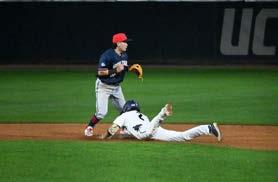
BY THEO KAYSER sports@theaggie.org
On Feb. 14, the UC Davis Aggies’ baseball team began their season, hosting the Gonzaga University Bulldogs for a three-game series over the weekend. Te Aggies walked away from the series with a win, capturing two victories across the three-game set. Gonzaga began the series ahead, securing a convincing 6-1 victory in the f rst game. T is was driven by a dominant pitching performance, including 11 strikeouts, as well as a series of defensive blunders from the Aggies, who had three errors in the game. Tese defensive mishaps proved costly in the ffth inning when two errors by UC Davis allowed for three runs to be scored by the Bulldogs. The Aggies retaliated the next day, winning 3-1. UC Davis scored methodically, beginning in the fourth inning. Riley Acosta, a fourth-year computer science major, and Mark Wolbert, a fourth-year managerial economics major, both singled to begin the inning, then advanced into scoring position after a passed ball.
From there, Korey Williams, a thirdyear undeclared major, hit a sacrifce fy ball to score for the Aggies. Wolbert was subsequently batted in, too, after a single from Alex Gouveia, a sixth-year human development major.
Te Aggies extended their lead in the following inning, after Joey Wright, a third-year communications major, hit a Runs Batted In (RBI) single to bring the score to 3-0 in the ffth.
All the while, starting pitcher Noel Valdez, a fourth-year human development major, kept the Gonzaga offense at bay, tossing six shutout innings. Carter Delaney, a Master of Management graduate student, then followed suit, notching his frst save of the season with two shutout innings
of his own.
Te rubber match, or fnal match of the series, saw UC Davis walking away victorious again, this time by a fnal score of 5-1.
Te Aggies again jumped out to an early lead with more small-ball ofensive tactics. At the bottom of the third inning, UC Davis drew three consecutive walks to load the bases with just one out. Williams then hit a single to drive in Ryan Lee, a thirdyear economics major, and Braydon Wooldridge, a third-year human development major, making the score 2-0.
After Gonzaga responded in the top of the fourth inning with a solo home run, UC Davis added a couple of insurance runs at the bottom of the inning. Tis came from Lee hitting a run-scoring single, knocking in Wolbert and Nick Leehey, a fourthyear communications major, after they had been bunted into scoring position.
Following a similar game script to the day prior, the Aggies coupled their ofensive approach with a lights-out pitching performance, this time led by 5.1 stellar innings from Tyler Wood, a second-year managerial economics major. Four Aggie arms then combined for a scoreless end to the game, allowing just three baserunners in the fnal 3.2 frames.
After a frst game that fell short on the run-prevention front, the Aggies shined on the pitching and defensive side to close the series. Across their two wins, UC Davis pitchers walked zero opposing batters and were rewarded for their strike-throwing abilities by their defense, who recorded zero errors. Going forward, the Aggies will look to continue their strong start to the season as they face of against the University of the Pacifc on Feb. 18, before their next series against Santa Clara University beginning Feb. 21.
Both teams dropped in Big West Conference rankings after losses to the Tritons
BY
LUICIENNE BROOKER sports@theaggie.org
Feb. 15 was a difcult day for UC Davis Aggies fans as both the men’s and women’s basketball teams lost to the UC San Diego Tritons. Te men’s team snapped their three-game winning streak with the overwhelming loss, and the women’s team fought hard but extended their losing streak to two games in a row.
The women’s team dropped to fourth in the Big West Conference rankings after their narrow 63-65 loss. Despite the undesired result, the Aggies gave a strong performance. Tova Sabel, a fourth-year psychology major and guard, scored 25 points, accounting for almost half of the UC Davis points scored. She also snagged a career-high 14 rebounds.
Although Sabel was the main engine behind the Aggie ofense for this game, she was assisted by Ryann Bennett, a frst-year undeclared major and guard, who came of of the bench to convert a total of nine points. It was a back-and-forth game, with the teams trading narrow leads for most of the frst quarter.
Te Aggies were able to gain a signifcant lead in the second quarter but the Tritons weren’t ready to be counted out. Tey fought back with 22 points in the fnal quarter, their highest total of any quarter in the game. Down three points in the fnal minute, the Aggies were able to pull one back but ran out of time before they could stage a comeback.
Although the teams sit on a twogame losing streak, there is plenty
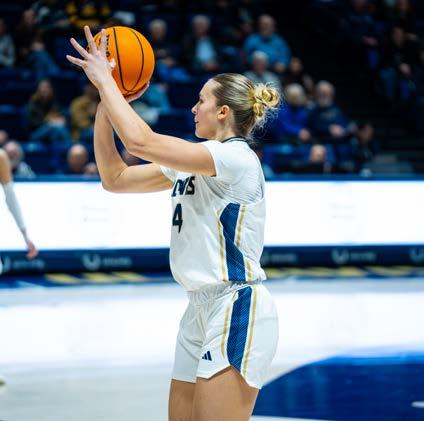
for fans to be optimistic about. Teir three most recent losses have been by three points or less, and there have been plenty of victories in between. Sabel’s performance has proven her to be unstoppable on ofense, and the Aggie defense has shown improved performance as well.
As the women’s game wrapped up at the University Credit Union Center, the men’s teams took the court in San Diego. With the Tritons ranked frst in the conference, the Aggies went into a difcult game outmatched, with the fnal score ending 60-85.
UC Davis kept pace with UC San Diego at frst, but the Tritons quickly ran up their lead. Nils Cooper, a secondyear human development major and guard, and TY Johnson, a fourth-year communications major and guard, led the team in scoring, both hitting double digits. However, it wasn’t enough for the Aggies to make a comeback against the Tritons, who secured their seventh victory.
After a long stretch of away games, the men’s team will play at home for all but one of their fnal games leading up to playofs. Te team will be aiming to use this home-court advantage to motivate the team and shake of the weariness of traveling and the recent loss.
Both teams are hoping to bounce back against California State University, Bakersfeld on Feb. 20 and California State University, Northridge on Feb. 22 as conference tournaments continue to approach. Te key for both teams is climbing their way up the rankings to secure those coveted top seeds for playofs.